The people of the Han Dynasty believed their region was situated at the center of heaven and earth, hence the term "China." Chinese painting is referred to as "Chinese painting," abbreviated as "guohua." Guohua is a traditional Han Chinese painting form, created by dipping a brush in water, ink, or pigments and painting on silk or paper.
The techniques are divided into: meticulous painting (white outline, light-color meticulous painting, heavy-color meticulous painting, and a blend of meticulous and freehand styles) and freehand painting (grand freehand and minor freehand). Meticulous painting is one of the earliest forms of Chinese painting, requiring precise and detailed portrayal of images with concise and summarized brushwork. It begins with outlining in ink before applying colors. Freehand painting gradually emerged after meticulous painting. With its refined brushwork, it transitions from depicting objects to emotions, and then to artistic conception, thus placing greater emphasis on the pursuit and portrayal of inner spirit.
Its content is divided into: figure painting (meticulous figures, freehand figures, boneless figures, and outline figures), flower-and-bird painting (detailed flower-and-bird, freehand flower-and-bird, boneless flower-and-bird, and outline flower-and-bird), and landscape painting (blue-green landscapes, light wash landscapes, golden landscapes, and ink wash landscapes). The foundation of figure painting is realistic representation, with the ultimate goal being to "capture the spirit." The principle proposed by Gu Kaizhi of the Eastern Jin Dynasty—"to express the spirit through form, achieving both form and spirit"—has always been the standard for figure painting creation. Flower-and-bird painting pursues "emotional appeal," as every plant and tree in nature can evoke boundless emotions. Chinese landscape painting emphasizes "freehand expression." "Expression" refers to "aesthetic conception," meaning "freely capturing the spirit of landscapes," where scenery conveys emotion and meaning is embedded within the scene, with the ideal being the harmonious integration of scenery and emotion.
Blue-green landscape painting: A type of landscape painting primarily using mineral pigments like azurite and malachite. Grand blue-green style features prominent outlines, minimal brushwork, rich coloring, and strong decorative qualities; small blue-green style lightly overlays blue-green hues over ink wash and light washes.
Shallow Vermilion Landscape Painting: Based on the techniques of ink sketching, stippling, and wash, this style of landscape painting is adorned with muted colors, primarily ochre, creating a refined, serene, and transparent aesthetic.
Golden and Lustrous Landscape: The primary colors are composed of three pigments—gold, cobalt blue, and verdigris. Gold is typically used for outlining mountain contours, rock textures, foothills, sandbars, colorful clouds, and architectural structures such as palaces and towers.
Ink Landscape Painting: A type of landscape painting that exclusively employs ink without the use of color. It emphasizes profound artistic conception and vivid energy, developing a complete set of expressive techniques centered around ink. The brushwork primarily relies on outlining, stippling, and dotting, excelling in depicting structure and texture. The ink techniques focus on the variations of ink's density, dryness, and wetness, with methods like splashing, breaking, layering, and warming as the main approaches, creating effects such as "ink diffusion" and "a fusion of five colors," which are adept at conveying volume and vitality.
The ancient Chinese people had already developed an awareness of landscape painting as early as the Neolithic Age (2147 BC and earlier), primarily reflected in patterns of trees and flowers on pottery. During the slave society period (Shang, Western Zhou, and Spring and Autumn periods, 2146–476 BC), the diverse motifs on bronze ware provided references for the abstract forms of Chinese landscape painting. By the Warring States period (475–221 BC), landscape textures had already appeared in murals and silk textiles. In the Qin and Han dynasties (221 BC–220 AD), the backgrounds of figure paintings in tomb murals began to feature simple scenic depictions. During the Wei, Jin, and Southern and Northern Dynasties (Three Kingdoms, Western Jin, Eastern Jin, and Southern and Northern Dynasties, 220–589 AD), under the development of Gu Kaizhi, landscape painting gradually broke free from serving as a backdrop for figure paintings and evolved into an independent genre.

Gu Kaizhi (Eastern Jin Dynasty, courtesy name Changkang, childhood name Hutou, 348-409 AD) *Admonitions of the Court Ladies*


Gu Kaizhi (Eastern Jin Dynasty, word length Kang, small character Hutou, 348-409 AD) "Ode to the Goddess of Luo"
Zong Bing (Southern Dynasty, courtesy name Shaowen, 375-443 AD) combined the ideas of Confucianism, Buddhism, and Taoism to write the "Preface to Painting Mountains and Waters" (around 430 AD), which marked the beginning of Chinese landscape painting theory and had an important influence on subsequent painting theories. This book first combines the ancient sages' love for mountains and waters with the "joy of benevolence and wisdom" and the fact that mountains and waters are a manifestation of the "Dao", and summarizes the beauty of mountains and waters; Then, it explains the reasons for creating the serene landscape, and further elucidates the establishment and significance of landscape painting; Proved the principle of using perspective to "preserve form" and further developed the concept of "form perception and integration into shadows"; Finally, the function and value of landscape painting are expressed through the phrase 'Chang Shen', demonstrating its spiritual liberation significance
Original text:
Saints embody the Tao and respond to things, while wise people embody the essence of the Dharma. As for mountains and waters, they are characterized by their quality and spiritual appeal, such as Xuanyuan, Yao, Kong, Guangcheng, Daqiao, Xuyou, and Guzhu. There must be journeys to Kongdong, Juci, Yaogu, Jishou, and Daming. Also known as the joy of benevolence and wisdom. Isn't it almost true that the wise are enlightened by the divine laws and the Tao, and the benevolent are delighted by the beauty of mountains and waters that flatter the Tao?
Yu is attached to Lu and Heng, and has a vast history of Jing and Wu, unaware of the approaching age. I feel ashamed of not being able to condense my qi and enjoy my body, and hurt the flow of the Stone Gate. Therefore, I painted images and colors, and constructed the Yunling Mountains.
Those who are beyond the realm of the Middle Ages can aspire to be below a thousand years; What is subtle beyond words and images can be taken from within the book and strategy. The situation depends on the state of the body, the state of the eyes, the state of the form, and the state of the color.
Given the vastness of Kunlun Mountain and the narrowness of its pupils, its shape cannot be discerned; If it is several miles away, it can be surrounded by inch eyes. If sincerity goes a little wider, then its vision will be even smaller. Today, if Zhang Xiao's silk reflects far away, then the shapes of Kun and Lang can be enclosed within a square inch. Draw three inches vertically, as high as a thousand feet; Horizontal ink measuring several feet, the body is as sharp as a hundred miles. It is natural for those who observe paintings to suffer from the misfortune of others, and not to burden them with small details. If so, the beauty of Song and Hua, as well as the spirit of Xuan Mu, can all be captured in one picture.
If the principle of understanding the mind is based on meeting the eyes, then the eyes should also meet and the mind should also understand. I should be able to feel the divine, and the divine is super rational. Although I am seeking the secluded rock, how can I add it? Once again, the essence of the spirit has been lost, and the sense of form and form is similar. The essence is reflected in the shadows, and it is truly capable of wonderful writing, but it is also completely sincere.
So he leisurely settled down, sipping his cup and playing the qin, draped himself in a secluded painting, and sat down to explore the four wastelands. It does not violate the will of heaven, but only responds to the wilderness without anyone. The peaks and valleys rise, the clouds and forests are vast, and the sages shine in unparalleled times, blending their divine thoughts with a myriad of interests. What is Yu Fu? Just a god of pleasure. Which comes first in the smoothness of God.
Translation:
Sages embrace nature, conform to all things, and wise people experience the world with pure hearts. Thus, they complement each other's scenery, so figures such as Xuan Yuan, Yao, Confucius, Guang Chengzi, Da Wei, Xu You, and Boyi Shuqi are destined to travel to Kongtong Mountain, Juci Mountain, Yaogu Mountain, Jishan Shouyang Mountain, and Daming Mountain. It can also be said that the benevolent enjoy mountains, while the wise enjoy water. The spirit of sages harmonizes with nature, enabling wise people to understand. Mountains and waters decorate nature with their beautiful scenery, bringing joy to kind people. Isn't this very similar?
I am deeply attached to Mount Lu and Mount Heng, and have been longing for Mount Jing and Mount Wu, but I don't know that I am gradually getting old. I feel ashamed that I can no longer travel, gather the spiritual energy of various mountains and rivers, and find peace and contentment. Sadness can only stumble on the shore of Shimen, so I use pictures and colors to depict the scenery of mountains and rivers surrounded by clouds.
The painting concepts that have been lost since the Han Dynasty can be pursued with great care in the following thousand years. Those that are not clearly expressed in legends and images can be found in books. Moreover, one can constantly experience it firsthand, observe it repeatedly with their eyes, describe the shape, and apply it according to the color.
Kunlun Mountain is tall, but human eyes are small. If Kunlun Mountain is close at hand, its full view cannot be seen. If it is a few miles away, it can be seen in its entirety. Of course, it is because at a slightly farther distance on the screen, the scenery appears very small. Now, when opening the canvas to depict a distant view, the majestic shape of Kunlun Mountains can be condensed into a square inch space. Draw three inches vertically, as if it were a thousand feet high; Splashing ink horizontally for a few feet can reflect the vastness of hundreds of miles. So for those who paint, the biggest fear is that the composition is not clever enough, and there is no need to worry about not looking like it because the painting is small. This is the original appearance of nature. In this way, the beauty of Mount Song and Mount Hua, as well as the spirituality of nature, can be displayed in one painting.
Taking pleasing to the eye and pleasing to the heart as the painting concept, then the composition will be clever, and clever composition will make it pleasing to the eye and pleasing to the heart. Being pleasing to the eye and pleasing to the heart will move one's spirit, and being uplifted will enable one's ideas to be realized. Even if painting with the theme of a recluse on a secluded rock, what's so difficult? In fact, there is no clue to the spirit itself. It is through the form in the painting that the composition is rendered, and the concept is integrated into the picture. Only when the painting is clever can it be satisfactory.
So I lived in seclusion, regulating my mood, drinking and playing the piano, unfolding my paintings and playing alone, so that I could travel around the world while sitting. Obey the trials of heaven and face the deserted countryside alone. Draw towering mountains and vast forests. It can make the sages leave a lasting impression and merge the myriad pleasures of the world into imagination. What else do I need to do? Just let your spirit flow freely. Spiritual joy, what could be more important than this.
Zhang Sengyao's original creation of "boneless landscape" was already a masterpiece in the art world at that time, and many later generations imitated it. He doesn't use a pen, he creates peaks, blue springs, and stones with heavy green colors alone, which is called boneless. Later generations referred to Zhang Sengyao, Gu Kaizhi, Lu Tanwei (founder of calligraphy in the Southern Dynasty, skilled in figure painting), and Wu Daozi (Tang Dynasty, known as the "saint of painting" and skilled in Buddhist figure painting) as the "Four Ancestors of Painters".
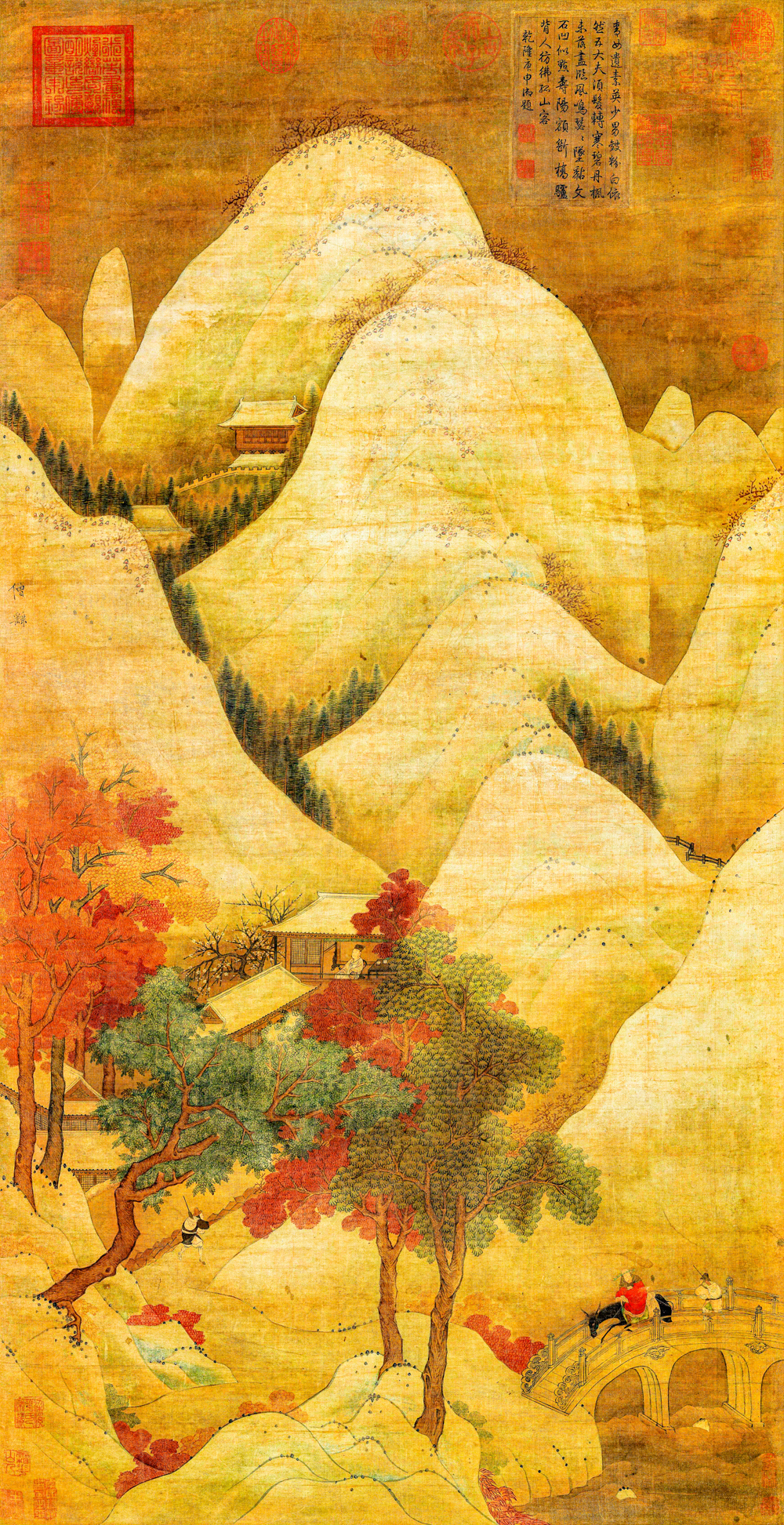
Zhang Sengyao (Southern Dynasty, birth and death years unknown) "Snowy Mountain Red Tree Diagram Axis"
The Spring Outing Painting by Zhan Ziqian during the Sui Dynasty (581-619 AD) is the earliest surviving authentic landscape painting. The characters in the painting are just scenery points. It changed from the Six Dynasties ink hook color blending method to the hook line filling and heavy color green method, pioneering the "green landscape".
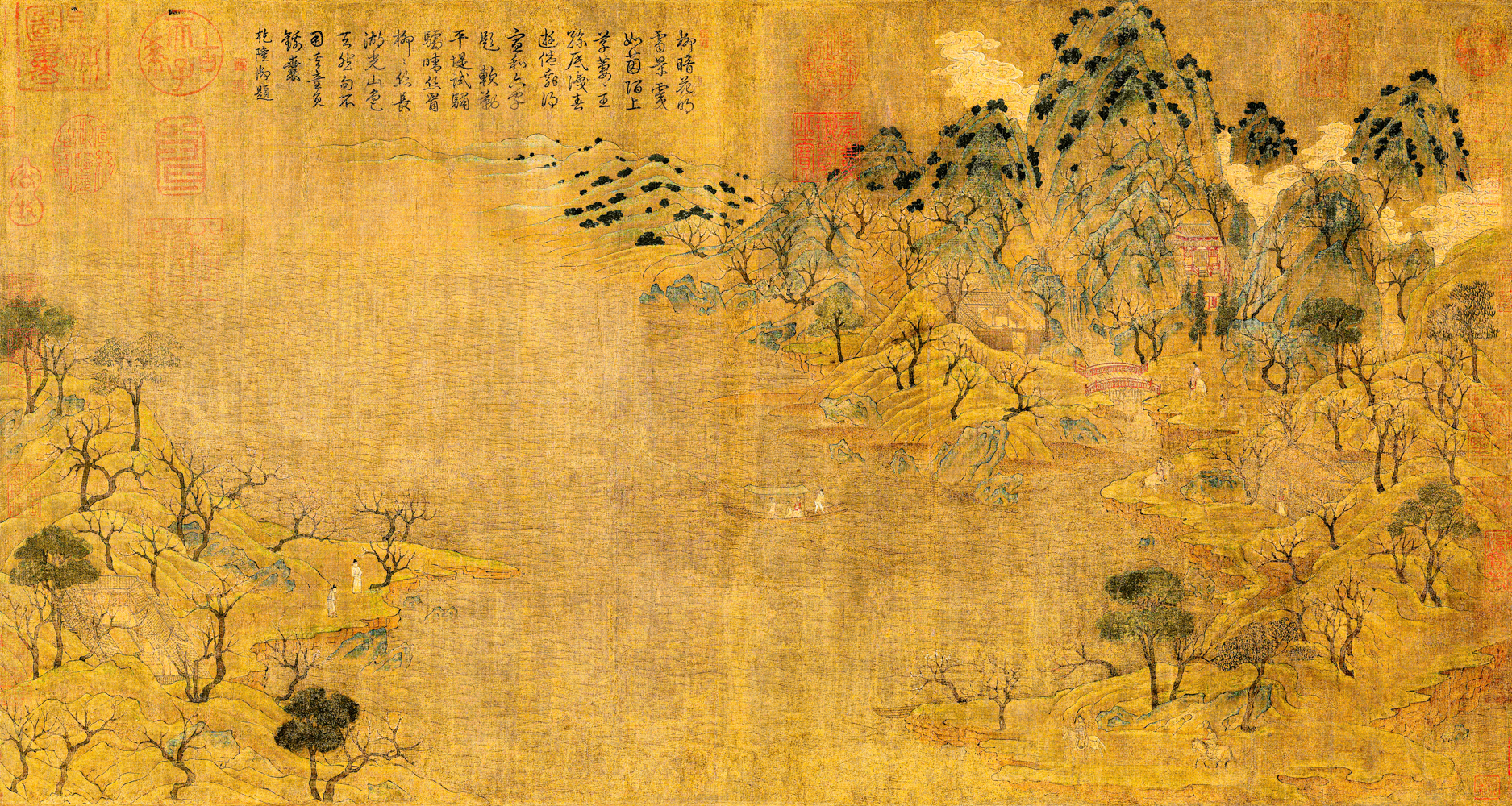
Zhan Ziqian (Sui Dynasty, 545-618) "Spring Outing Picture"
The Tang Dynasty (618-907 AD) had a developed economy and stable society, and Chinese landscape painting matured and entered a period of prosperity, resulting in various styles competing to emerge. The Tang Dynasty created two major schools of landscape painting: one inherited the traditional expression techniques of "green landscape" by Zhan Ziqian, and developed into a meticulous and exquisite style with golden and blue reflections, which later became known as "Beizong Landscape". One faction, represented by Wang Wei, has a flowing style, heavy rendering, and relatively simple painting. They extend the lines to the surface and use ink instead of color. Later generations called it "Nanzong Shanshui", and Wang Wei was revered as the founder of "Nanzong Shanshui".

Li Sixun (Tang Dynasty, courtesy name Jian Sui, first work Jian Jing, 653-716 AD) "Jiangfan Pavilion Map"
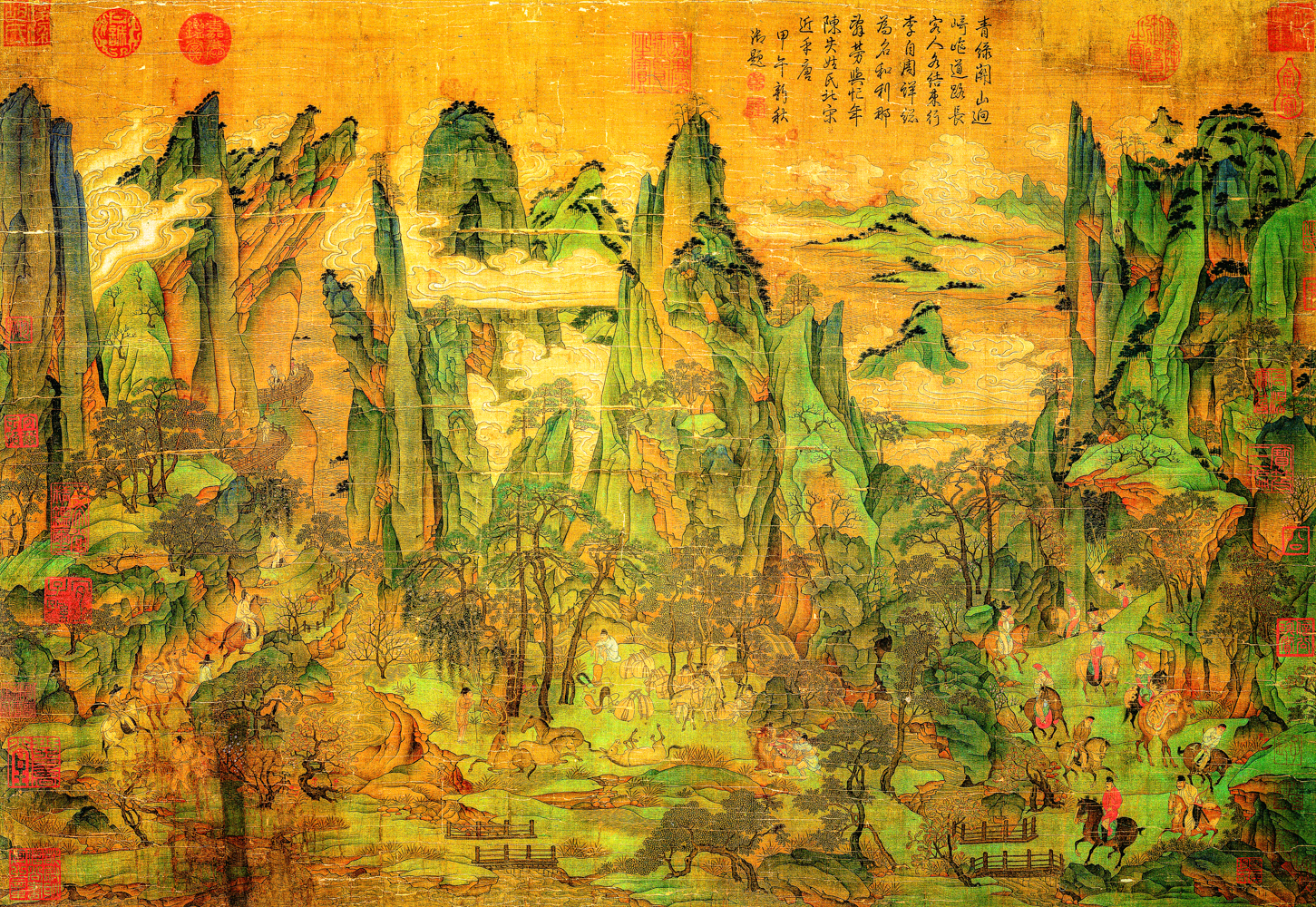
Li Zhaodao (Tang Dynasty, courtesy name Xijun, 675-758 AD) "Ming Emperor's Visit to Shu"

Wang Wei (Tang Dynasty, courtesy name Mojie, literary name Mojie Jushi, 701-761 AD) "Snowy Skies in Jianggan"
During the Five Dynasties and Ten Kingdoms period (907-960 AD), Jing Hao transformed the techniques of filling and dyeing into "texturing", which was a significant change in the techniques of Chinese landscape painting. Jing Hao, through his own artistic practice, summarized the theories of predecessors and wrote "Record of Brushwork", establishing a complete theoretical system for "ink landscape painting". His "Kuang Lu Tu" is a large-scale panoramic landscape painting with distinct layers, both textured and dyed, and a powerful momentum. Guan Tong diligently studied and delved into Jing Hao's skills, and ultimately emerged victorious over him. He is known as one of the "Four Great Landscape Painters" along with Jing Hao, Dong Yuan, and Ju Ran. Ranked alongside Li Cheng and Fan Kuan as one of the 'three dominant families'.
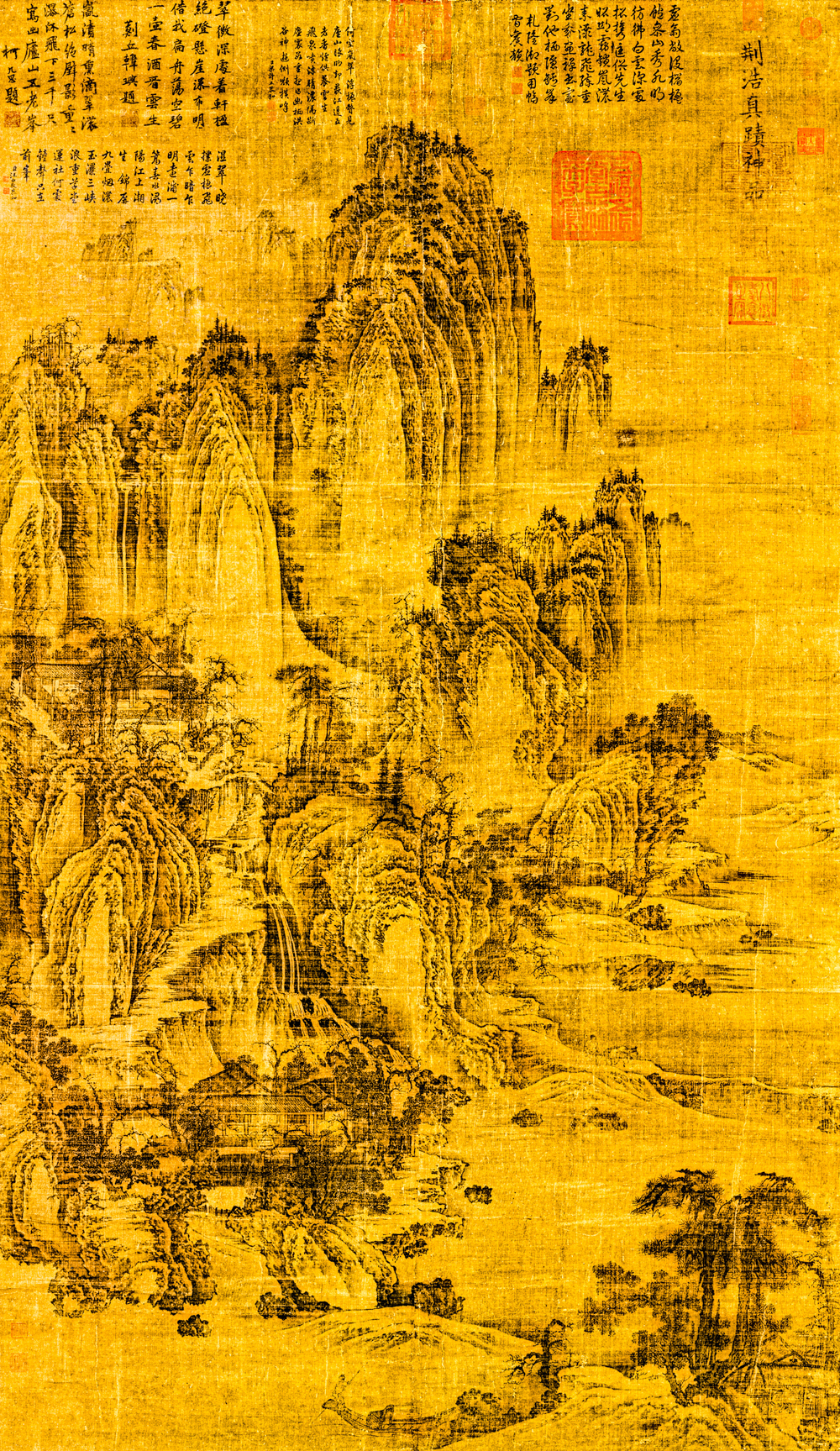
Jing Hao (Five Dynasties, courtesy name Haoran, literary name Hongguzi, 850-911) "Kuang Lu Tu"

Guan Tong (Five Dynasties, 907-960) "Travel Map of Guanshan"
During the Northern Song Dynasty (960-1127 AD), landscape painting reached an unprecedented period of prosperity and flourishing, with many famous artists emerging and shining like stars. Form a "Northern style" and a "Southern style" in terms of style. The Northern Faction is strong and upright, with the backbone of the Qin Long Mountains and waters, represented by Li Cheng, Fan Kuan, and Guo Xi. The Southern School, known for its "light ink and light mist," embodies the grandeur of Jiangnan's mountains and rivers. Led by Dong Yuan and Ju Ran, it is believed to be the official biography of the Southern School's mountains and rivers in later generations. Dong Yuan, Li Cheng, and Fan Kuan are collectively known as the "Three Great Masters of the Northern Song Dynasty". Lin Quan Gao Zhi Ji "is a collection of quotations compiled by Guo Si, the son of Guo Xi. It first proposed the concept of" realm "in landscape painting, including a series of important aesthetic propositions such as" three distant (flat, high, and profound) "and" four movable (walking, observing, living, and playing) ". Han Zhuo's "Complete Works of Pure Landscape" records his artistic insights. The book emphasizes that painters should be knowledgeable and knowledgeable, learning from the principles of nature and the patterns of ancient people. At the same time, it specifically describes natural laws such as mountains and rivers, as well as the four seasons of dawn and dusk. Based on Guo Xi's "Three Distances", it also lists the shapes and structures of broad, mysterious, secluded, and painted stones (collectively referred to as the "Six Distances"), and lists various landscape painting techniques such as the use of hemp, dotted, and chopped patterns.

Li Cheng (Northern Song Dynasty, courtesy name Xianxi, literary name Yingqiu, 919-967 AD) "Maolin Yuanxiu Map"
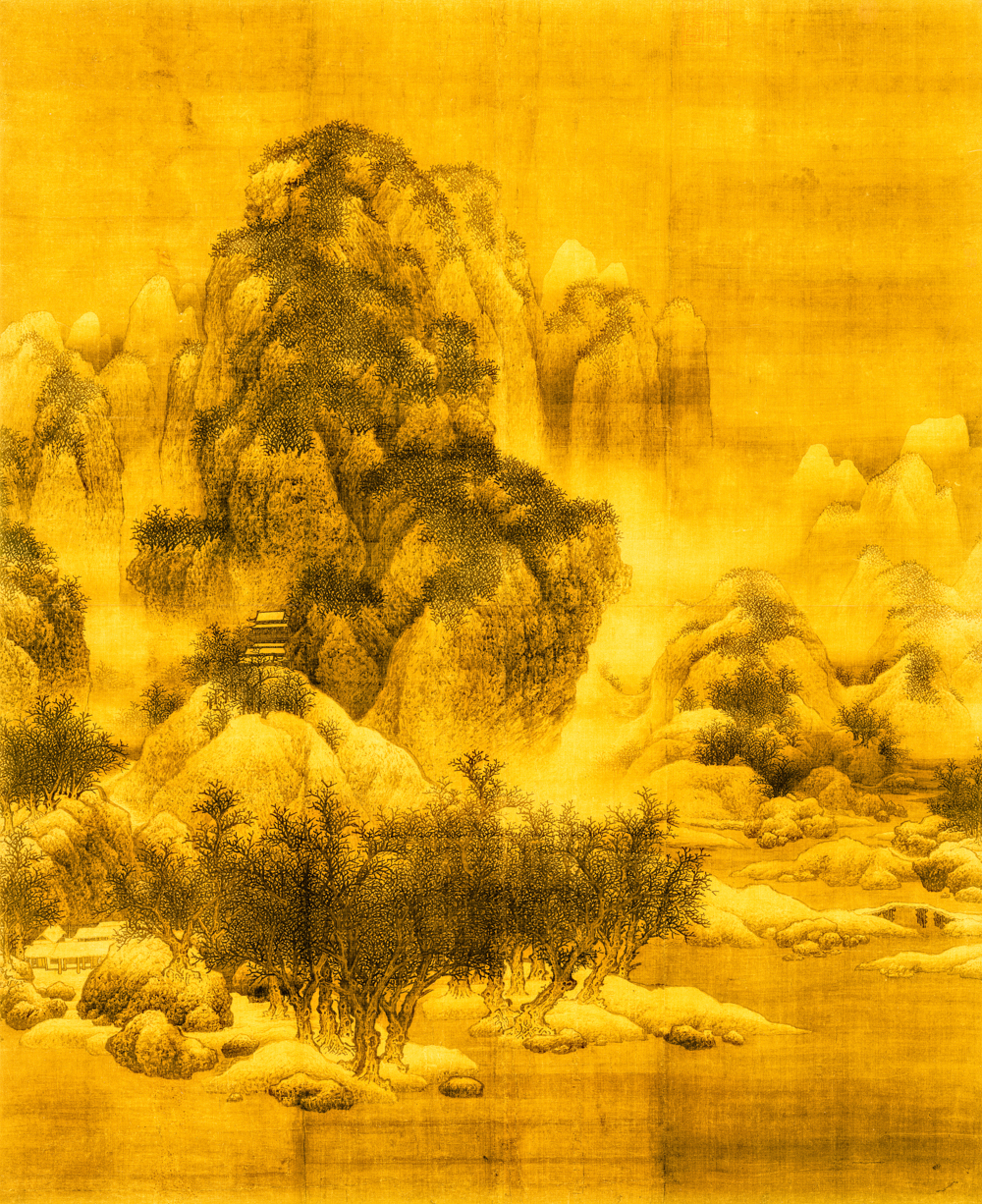
Fan Kuan (Northern Song Dynasty, also known as Zhongzheng, styled Zhongli, 950-1032) "Snowy Scenery and Cold Forest"

Guo Xi (Northern Song Dynasty, courtesy name Chunfu, 1023-1085) "Spring Snow on Guanshan Mountain"

Dong Yuan (Northern Song Dynasty, courtesy name Shuda, 937-962) "Xiaoxiang Map"
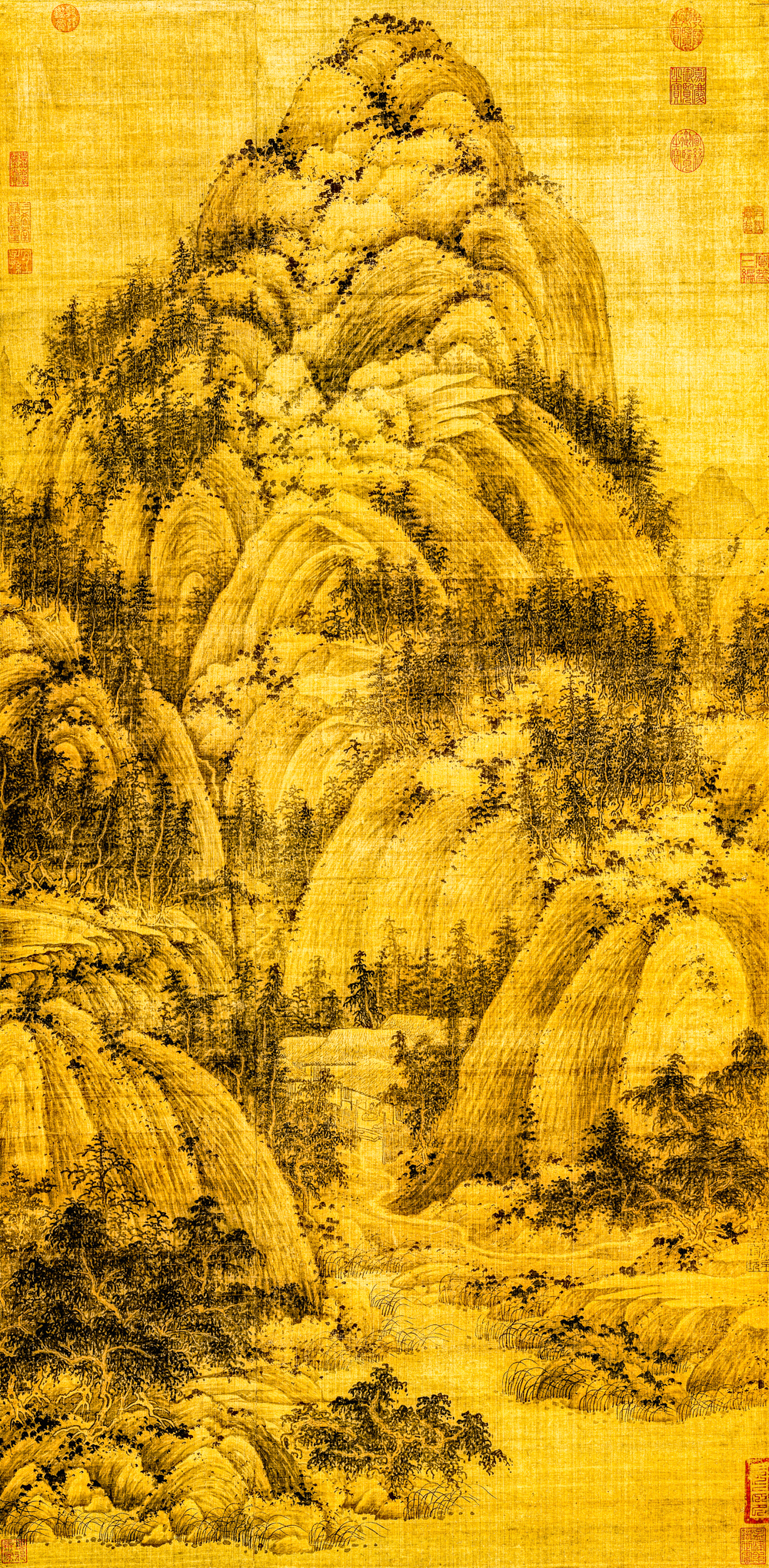
Ju Ran (Northern Song Dynasty, birth and death years unknown) "Qiu Shan Wen Tu"

Mi Fu (Northern Song Dynasty, originally named Fu, later changed to Fu, courtesy name Zhang, self proclaimed name Mi or Mi, 1051-1107) "Spring Mountain Rui Song Tu"

Mi Youren (Northern Song Dynasty, also known as Yin Ren, styled Hui, nicknamed Yin Ge and Ao Er, later known as Lazy Old Man, 1074-1153) "The Wonders of Xiaoxiang"



Wang Ximeng (Northern Song Dynasty, 1096-1119) "A Thousand Miles of Mountains and Rivers Scroll"
During the Southern Song Dynasty (960-1127 AD), Li Tang, Liu Songnian, Ma Yuan, and Xia Gui rose to prominence and were known as the "Four Masters of the Southern Song Dynasty". They created a new style of ink painting that was vigorous and vigorous, integrating the powerful and upright brushstrokes of the Northern School with the clear and rich ink techniques of the Southern School. The landscape paintings of the Song Dynasty were like blooming mountain flowers, colorful and vibrant, showcasing the great creative talent of the painters. Many expression methods of landscape painting originated in the Song Dynasty. In terms of texturing techniques, Dong Yuan and Ju Ran created the hemp tattooing technique, Fan Kuan created the raindrop tattooing technique, Mi Fu created the rice dot tattooing technique, and Li Tang created the axe chopping tattooing technique, all of which were commonly used in later generations; Speaking with ink and brush, dry brush, wet brush, broken brush, accumulated brush, and splashed brush are all prepared; In terms of layout, both panoramic and corner views are used.
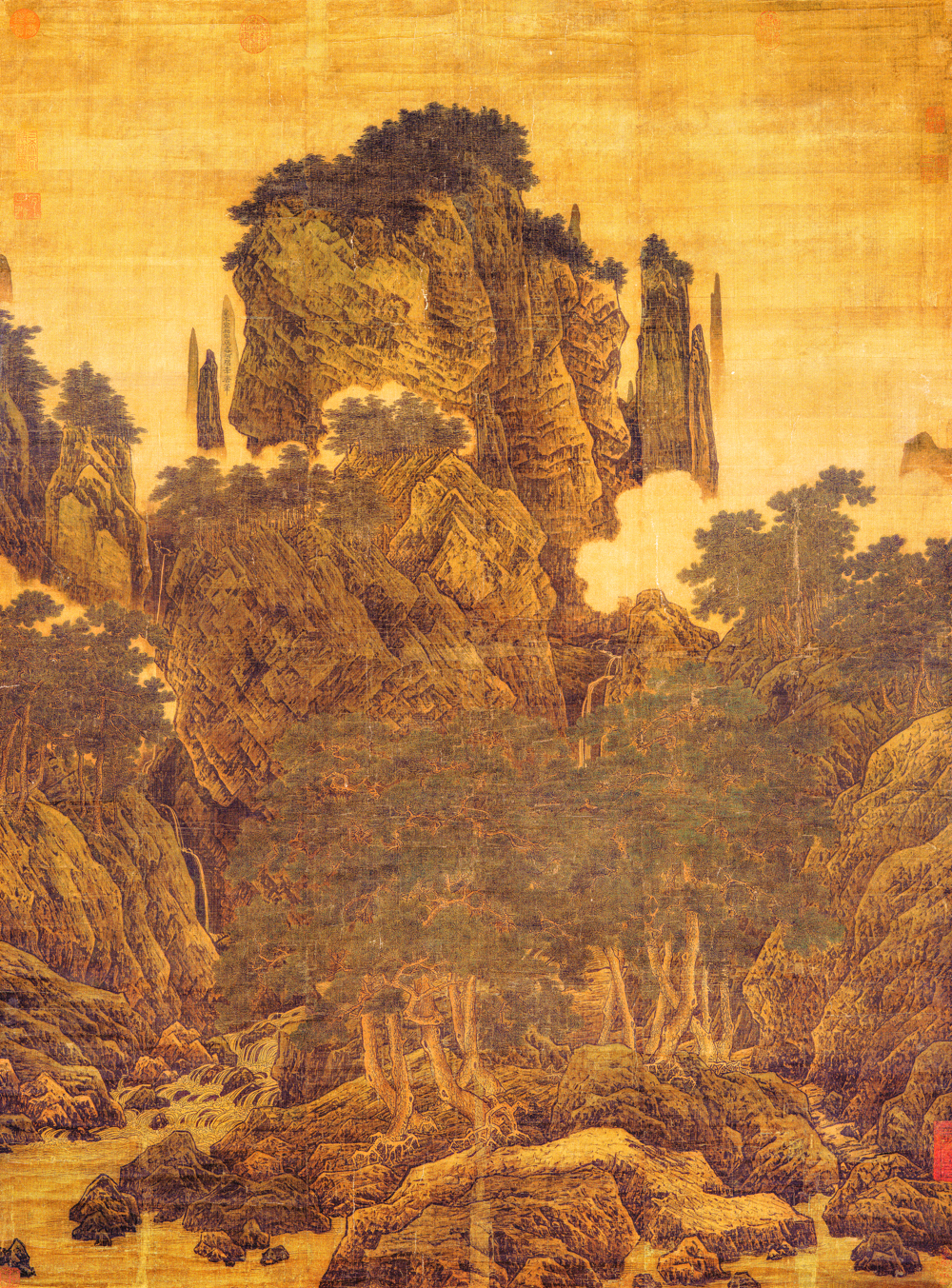
Li Tang (Southern Song Dynasty, courtesy name Xigu, 1066-1150) "Pine Wind in Wanhe"

Liu Songnian (Southern Song Dynasty, self proclaimed Qingbo, also known as "Liu Qingbo" or "Dark Gate Liu", also known as "Xiaojing Shanshui", 1131-1218) "Four Jing Mountains Water Map"

Ma Yuan (Southern Song Dynasty, courtesy name Yaofu, literary name Qinshan, 1140-1225) "Treading on Songs"




Xia Gui (Southern Song Dynasty, courtesy name Yuyu, birth and death years unknown) "Map of Ten Thousand Miles of the Yangtze River"

Zhao Boju (Southern Song Dynasty, courtesy name Qianli, birth and death years unknown) "Autumn Scenery of Jiangshan"
The Yuan Dynasty (1127-1276 AD) was a significant period of transformation in landscape painting. Qian Xuan's "Dwelling on Floating Jade Mountain" is an attempt to seek the coordination between transparent color and ink color to unify the picture. Color is here, whether it is the large blue-green filled with empty hooks or the experimental small blue-green, they are actually in a state of development and exploration. Since the Northern Song Dynasty, the retro trend has influenced Qian Xuan's demand for subtle and delicate color processing in seeking a fresh and elegant new artistic conception, completing the transition from the realm of "wealthy and noble immortals" to the realm of "reclusive immortals". The expression form of Yuan Dynasty landscape painting gradually shifted from color before the Five Dynasties, and through the period of color and ink painting complementing each other in the Two Song Dynasties, ink painting dominated the painting world by the Yuan Dynasty. Zhao Mengfu's viewpoint of "painting and calligraphy sharing the same origin" in the early Yuan Dynasty led to the climax of the most Chinese ink landscape painting. literati painters further developed calligraphy, Literary cultivation was applied to painting, emphasizing the interest of brush and ink, and emphasizing the interpretation of brush and ink. It represented the "Four Masters of Yuan Dynasty Landscape Painting" Huang Gongwang, Wang Meng, Ni Zan, and Wu Zhen, through practice, reflected and developed the aesthetic thinking of emphasizing the law over the meaning that was commonly seen among literati at that time. They advocated painting with meaning as the top priority and form as the secondary priority, disregarding theory and method, valuing interest, and emphasizing the expression of personal emotions through painting. They went from learning from nature to learning from the heart of the law, thus impacting the old art world that had been popular since the Song Dynasty in terms of ideology and theory.

Qian Xuan (Yuan Dynasty, courtesy name Shunju, literary name Yutan, also known as Xunfeng, Chuanweng, also known as Qinglaolaoren, Chuanweng, Xilanweng, etc., 1239-1299) "Dwelling on Floating Jade Mountain"

Zhao Mengfu (Yuan Dynasty, courtesy name Ziang, literary name Songxue Daoren, also known as Crystal Palace Daoren, Ou Bo, 1254-1322) "Autumn Colors of Magpie Blossoms"


Huang Gongwang (Yuan Dynasty, Ming Gongwang, courtesy name Zijiu, literary name Yifeng, Da Chi Daoren, etc., 1269-1354) "Dwelling in Fuchun Mountain"
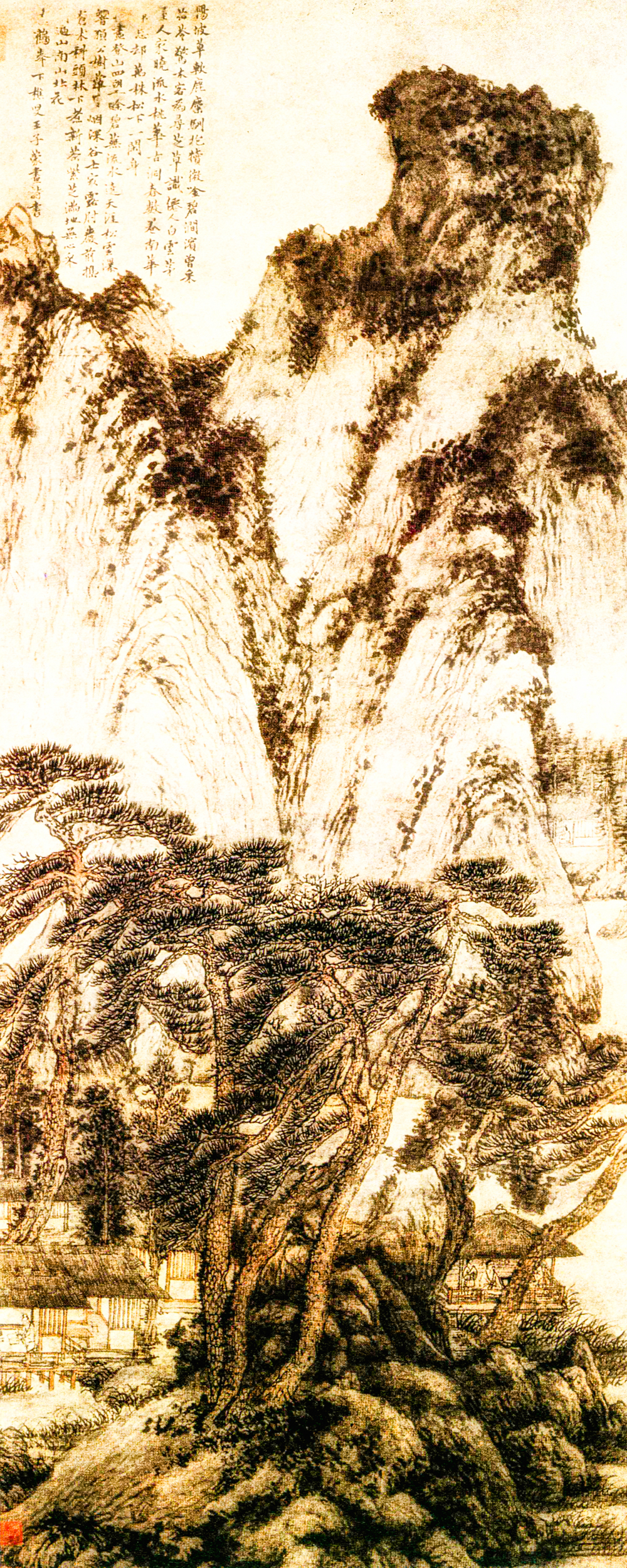
Wang Meng (Yuan Dynasty, courtesy name Shuming, literary name Huangheshan Qiao, Xiangguang Jushi, etc., 1308-1385) "Chunshan Reading Picture Axis"
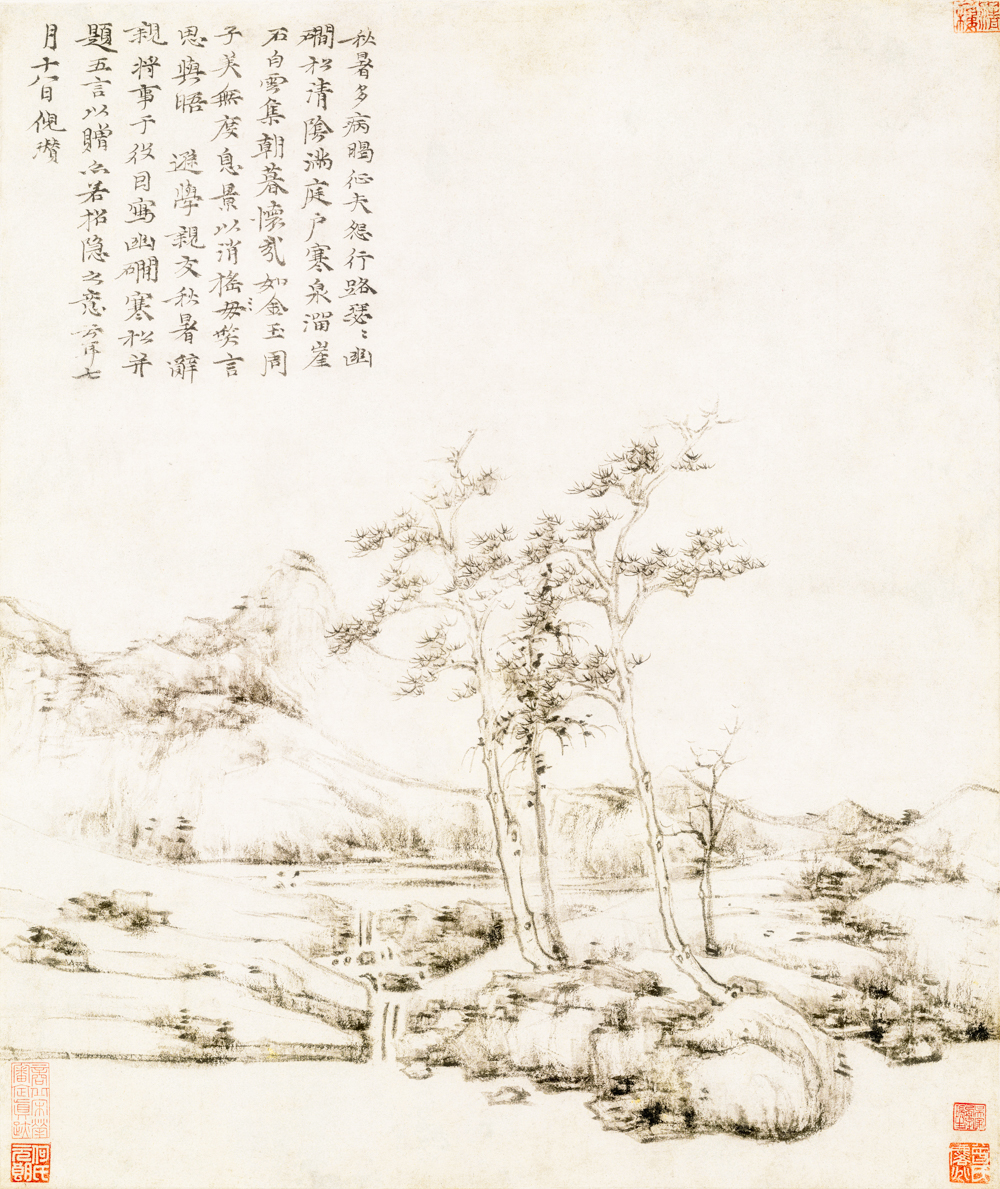
Ni Zan (Yuan Dynasty, first name Ni Yue, courtesy name Taiyu, alternate name Yuanzhen, courtesy names Yunlinzi, Jingmanmin, Huanxiazi, 1301-1374) "Cold Pine Map of Youjian"

Wu Zhen (Yuan Dynasty, courtesy name Zhonggui, naturally fond of plum blossoms, self proclaimed as Meihua Taoist, also known as Meisha Mi or Meihua Monk, 1280-1354) "Fishing Hidden Map"
The landscape painting of the Ming Dynasty (1368-1644 AD) had diverse styles in terms of form, with the emergence of complex and diverse schools, demonstrating the prosperity of the landscape painting world; But in terms of content, it is becoming increasingly vague, and painters tend to imitate the brush and ink of ancient people. In the early Ming Dynasty, the Zhejiang School, represented by Dai Jin, had the greatest influence and inherited the painting styles of Ma Yuan and Xia Gui from the Southern Song Dynasty without any innovation; In the mid Ming Dynasty, the Wu School of Painting, represented by the "Ming Four Schools" of Shen Zhou, Wen Zhengming, Tang Yin, and Qiu Ying, dominated the landscape painting scene. Their masters were Dong Yuan and Ju Ran, who took over the mantle of the "Yuan Four Schools" and painted the landscapes of Suzhou; In the late Ming Dynasty, Dong Qichang and others systematically advocated the revival of traditional Chinese painting from theory to practice, with the ability to imitate predecessors. As a result, Chinese landscape painting art fell into the circle of ancient people and had little creativity. Zhou Chen is known as a non imperial "imperial" painter. Tang Yin and Qiu Yingqing were more than blue in style, but their fame had already surpassed that of their teachers at that time.
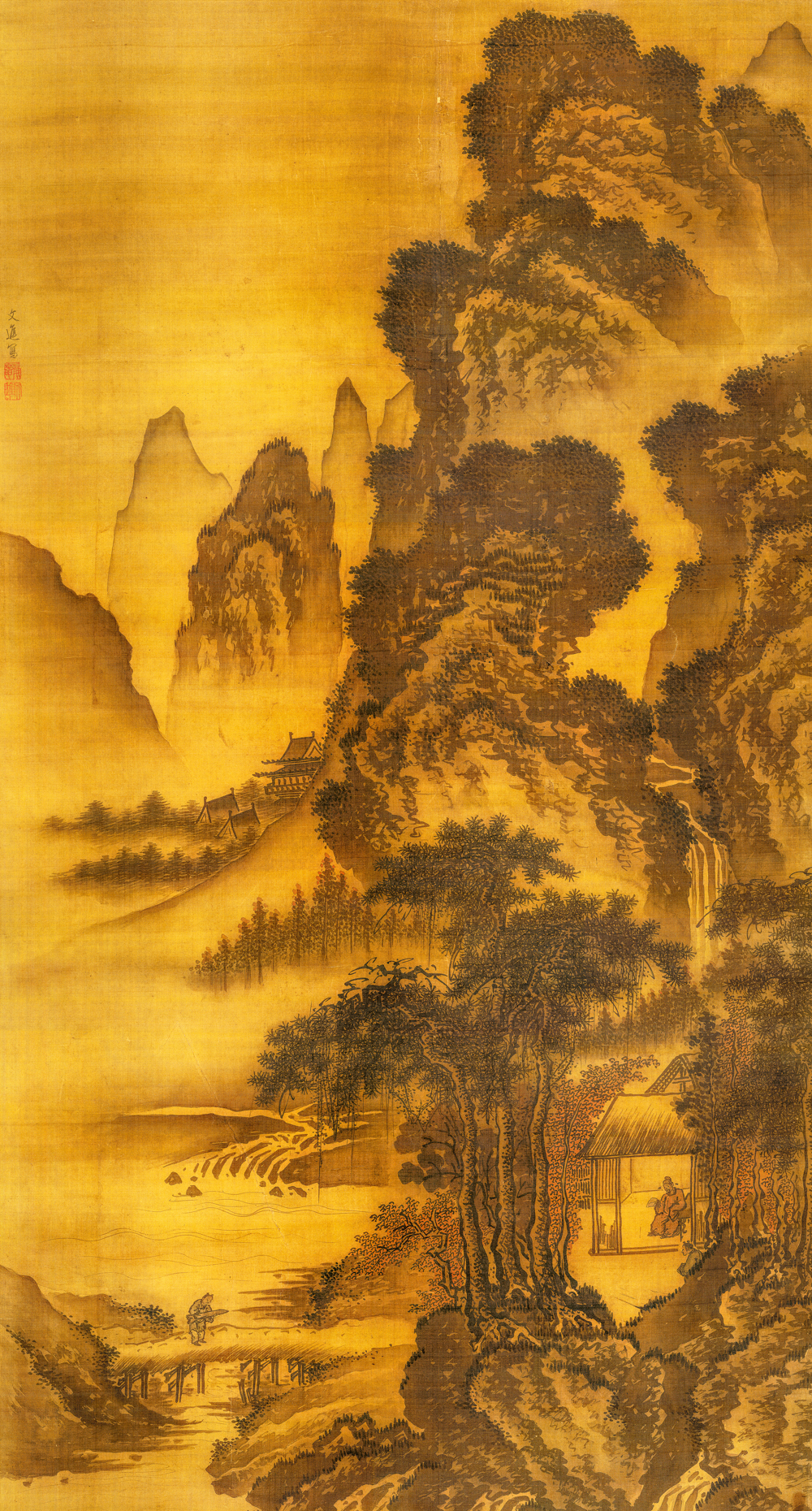
Dai Jin (Ming Dynasty, courtesy name Wenjin, literary name Jing'an, born in Yuquan Mountain, 1388-1462) "Poetic Picture of Xitang"

Shen Zhou (Ming Dynasty, courtesy name Qinan, literary name Shitian, late literary name Baishiweng, 1427-1509) "High Map of Mount Lu"

Wen Zhengming (Ming Dynasty, originally named Bi (also known as Bi), courtesy name Zhengming, later known as Zhengzhong, and given the nickname Hengshan Jushi, 1470-1559) "The Thousand Peaks Competing for Beauty"

Tang Yin (Ming Dynasty, courtesy name Bohu, later changed to Ziwei, also known as Liuru Jushi, Taohua Anzhu, Tang Sheng of the State of Lu, and Escaping Zen Immortal Official, etc., 1470-1524) "Canglang Tu"
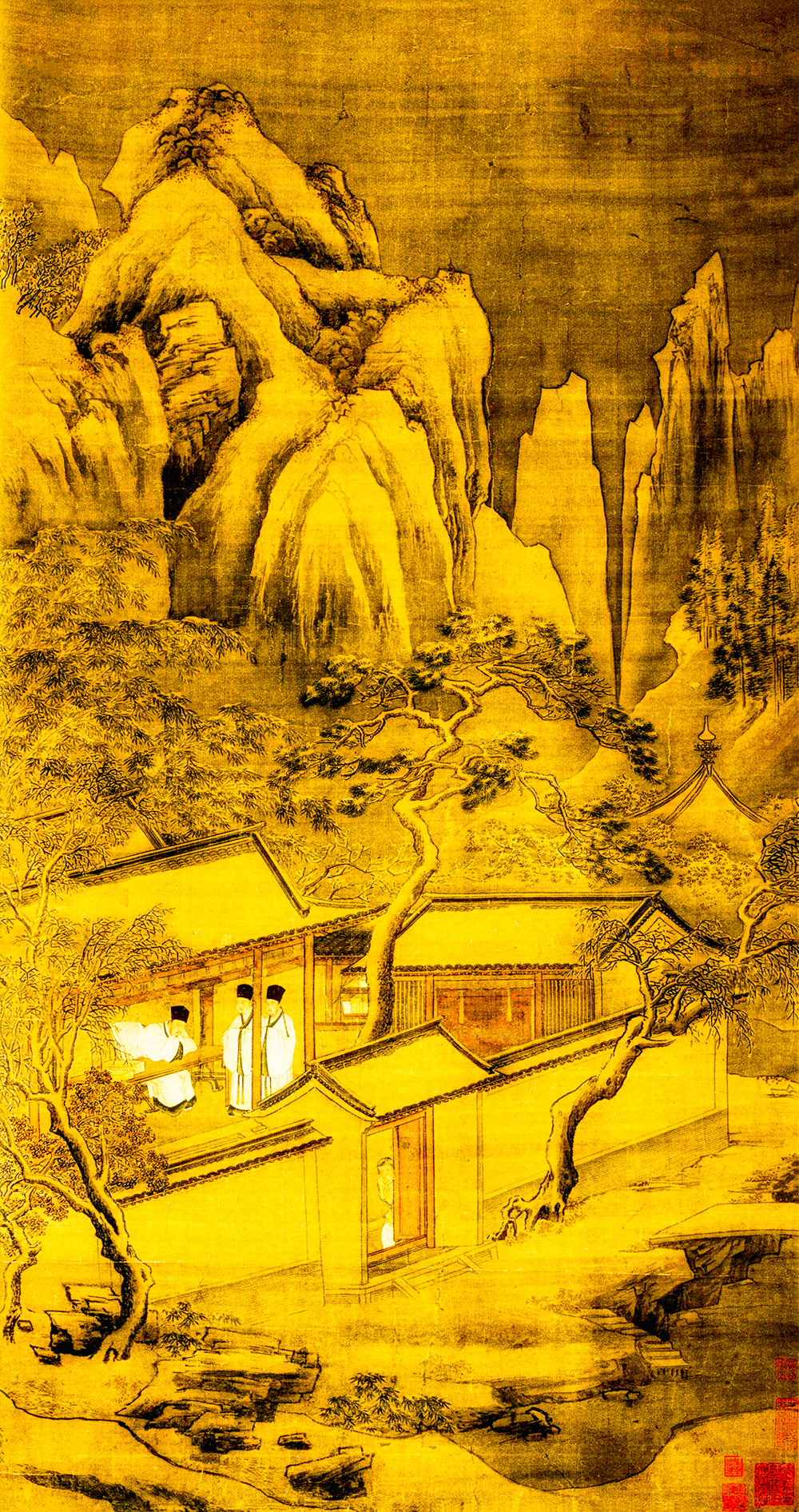
Qiu Ying (Ming Dynasty, courtesy name Shifu, also known as Shifu, pseudonym Shizhou, born in Taicang (now part of Jiangsu), birth and death years unknown) "Cheng Men Li Xue Tu"

Dong Qichang (Ming Dynasty, courtesy name Xuanzai, literary names Sibai and Xiangguang Jushi, 1555-1636) "Eight Scenic Spots of Autumn"

Zhou Chen (Ming Dynasty, courtesy name Shunqing, literary name Dongcun, 1460-1535) "Spring Mountain Cavalry Tour"
In the early Qing Dynasty (1644-1912 AD), the "Four Wangs" (Wang Jian, Wang Chong, Wang Shimin, Wang Yuanqi) (the "Yushan School" led by Wang Jian and Wang Chong, and the "Loudong School" or "Taicang School" led by Wang Shimin and Wang Yuanqi) summarized many of the experiences and insights of their predecessors in the field of brush and ink in imitating ancient styles (the brush techniques of the Song and Yuan dynasties were considered "orthodox"), and made contributions to the organization and research of painting heritage. Dai Xi (Yushan School and Loudong School style), Zhang Yan (Jingjiang School), Qian Du (Songhu School), Cai Jia and others criticized the Four Princes for their favoritism, but the actual effect was minimal. Gong Xian is a landscape painter who values both traditional brushwork and the art of imitation. His creation is based on the painting techniques of Dong Yuan and Ju Ran from the Five Dynasties period, with the brush and ink of the Northern School of Painting in the early Song Dynasty as the main body, and incorporating the brush style and ink rhyme of Er Mi (father and son of Mi Fu and Mi Youren), Wu Zhen, Shen Zhou, and others. At the same time, combined with his own observation and feelings of natural landscapes, he formed a simple yet elegant ink accumulation method, which is different from the ancient style of writing advocated by the "Four Kings" led by Wang Shimin in the early Qing Dynasty. The Four Painting Monks, represented by Hongren, Kun Can, the Eight Great Mountain People, and Shi Tao, are the Wild Yi School painters. They took the Xin'an River Basin and Mount Huangshan Mountain as their bases, swept away the wind of ancient times, and created a new path of sketching. Their unconventional painting style has brought new peaks to the landscape of the Qing Dynasty. Their strong personalities and profound theories have had a great influence on the modern art world. Especially Shi Tao, who not only draws on the strengths of his predecessors but also depicts the truth of life, creating many unique landscape paintings. In his book "Shi Tao Painting Quotes", he put forward a series of creative ideas such as "the ancient cannot be used", "brush and ink should follow the times", "borrowing from the past to open up the present", "one painting" theory, "searching for all the peaks and sketching", which effectively challenged the dull atmosphere of the landscape painting industry for hundreds of years and opened up a new path. The Jingjiang School (Dantu School), Songhu School, and Hai School (Four Great Masters of the Sea: Xugu, Puhua, Renyi, and Wu Changshuo) emerged successively during this period.

Wang Jian (Qing Dynasty, courtesy name Zhao, also known as Yuanzhao, alias Xiangbi, Ranxiang Ancestral Master, from Taicang, Jiangsu, 1598-1677) "Dwelling in Linxi Mountain"

Wang Chong (Qing Dynasty, courtesy name Shigu, literary name Gengyan Sanren, Jianmen Qiaoke, Wumu Shanren, Qinghui Laoren, etc., 1632-1717) "Poetry and Thoughts in Xitang"
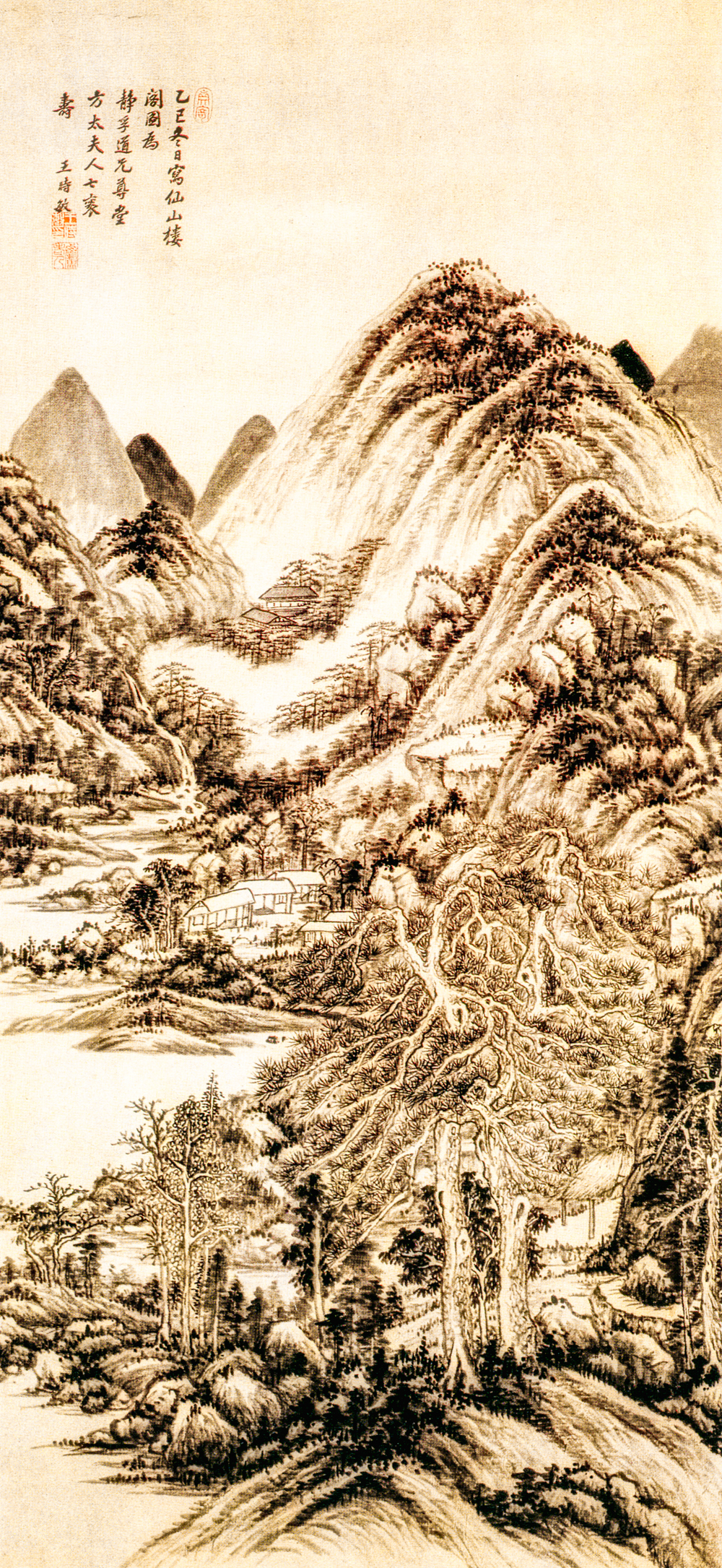
Wang Shimin (Qing Dynasty, real name Wang Zanyu, courtesy name Xunzi, literary name Yanke, also known as Youxie Daoren, and later known as Xilu Laoren, 1592-1680) "Xianshan Pavilion Map"
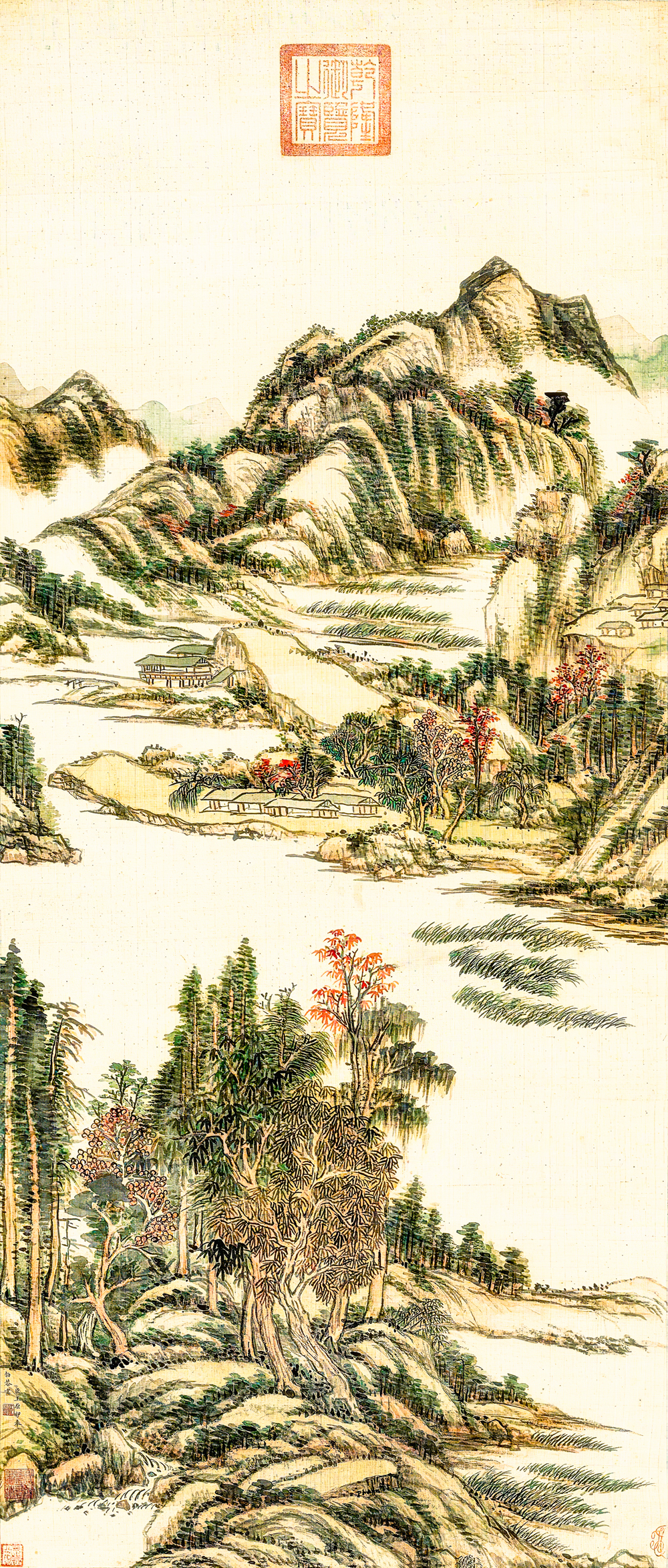
Wang Yuanqi (Qing Dynasty, courtesy name Maojing, literary name Lutai, Shishi Daoren, 1642-1715) "Autumn Forest Distant Daitu"

Dai Xi (Qing Dynasty, courtesy name Chunshi, literary name Yu'an, literary names Lucha, Chunxi, Songping, and Jingdong Jushi, 1801-1860) "Remembering the Pine"

Zhang Yin (Qing Dynasty, courtesy name Baoya, style names Xi'an, Xi Daoren, also known as Qiaoshan Jushi, Guanbai Jushi, etc., 1761-1829) "Elegant Interest in a Plum Forest"

Qian Du (Qing Dynasty, originally named Yu, courtesy name Shumei, later renamed Du, courtesy name Shumei, style names Songhu Xiaoyin, also Songhu, also known as Hugong, style name Jushi, 1764-1845) "Moonlit Stroll at Yushan Thatched Cottage"

Cai Jia (Qing Dynasty, courtesy name Songyuan, also Cen Zhou, style names Xuetang, also Lüting, also known as Zhufang Laomin, 1686-1779) "Blue Mountains and Green Waters"




Gong Xian (Qing Dynasty, also known as Qi Xian, courtesy names Banqian, Banmu, style names Yeyi, also Chai Zhangren, Zhongshan Yelao, 1618-1689) "Scroll of Myriad Peaks and Valleys"
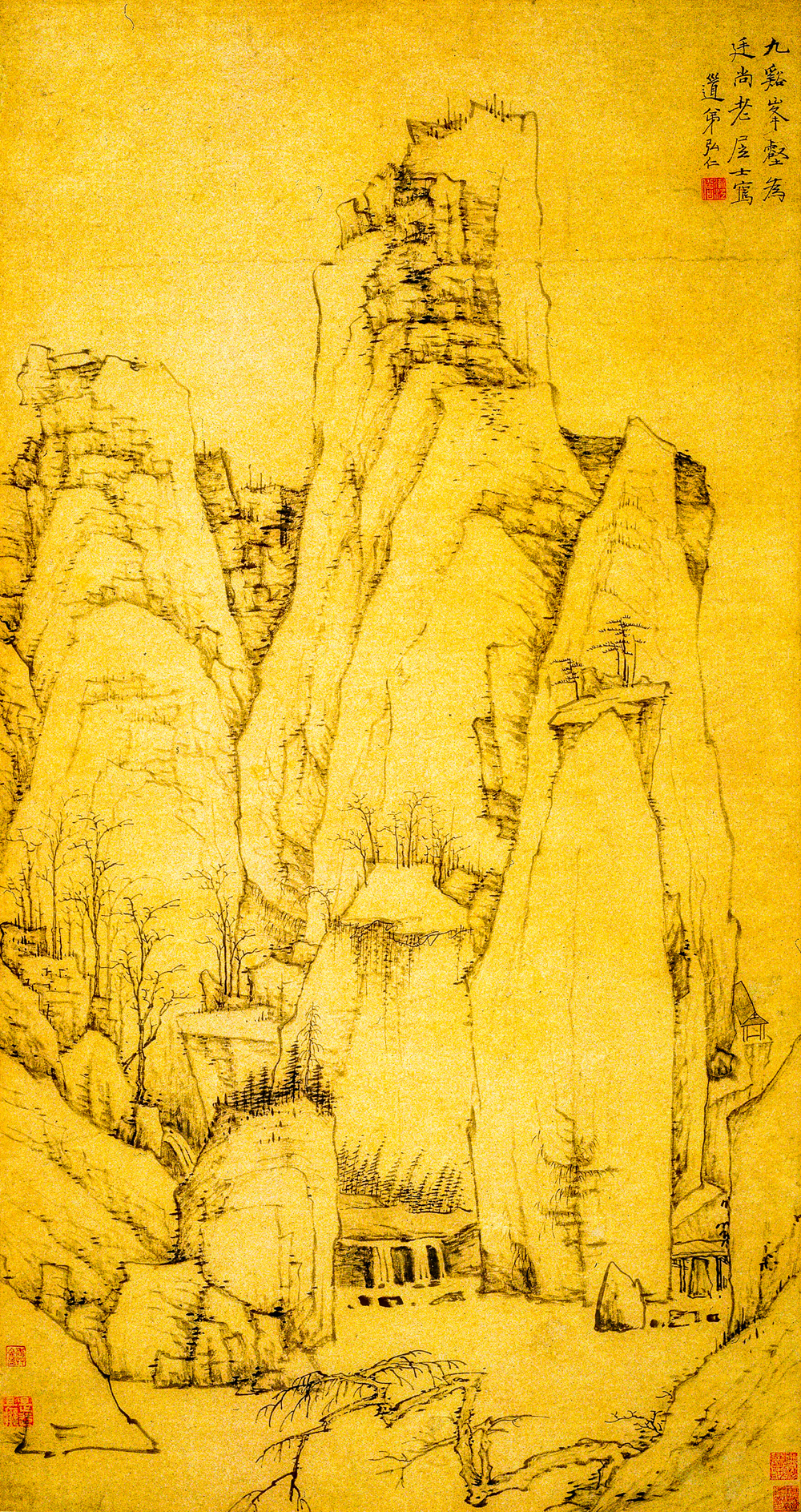
Hong Ren (Qing Dynasty, secular surname Jiang, name Tao, courtesy name Liuqi, monastic name Hongren, style names Jianjiang Xueren, also Wuzhi, Meihua Guná, 1610-1663) "Hanging Scroll of Peaks and Ravines at Jiuxi"

Kun Can (Qing Dynasty, secular surname Liu, monastic name Kuncan, courtesy name Jieqiu, style names Shixi, Baitū, Shi Daoren, Shixi Daoren, Candao Zhe, Dianzhu Daoren, 1612-1692) "Layers of Peaks and Verdant Greenery"

Zhu Da (Qing Dynasty, originally named Zhu Tongqian, courtesy name Ren'an, style names Badashanren, Xuege, Geshan, Renwu, Daolang, etc., 1626-1705) "Fishing Alone by a Mountain Stream"

Shi Tao (Qing Dynasty, secular surname Zhu, name Ruoji, childhood name A Chang, monastic name Yuanji, also Yuanji, style names Shitao, Dazi, Dungen, Shi Daoren, Kugua Heshang, Xia Zunzhe, Qingxiang Chenren, Qingxiang Laoren, Qingxiang Yiren, Lingding Laoren, 1642-1708) "Fishing Boat on Hengtang"

Xu Gu (Qing Dynasty, secular surname Zhu, name Huairen, monastic name Xubai, courtesy name Xugu, style name Ziyang Shanmin, Juanhe, studio names Juefei An, Gubai Caotang, Sanshiqi Feng Caotang, 1823-1896) "Thatched Cottage in the Mountain Shade"

Pu Hua (Qing Dynasty, courtesy name Zuoying, also Zhuying, Zhuyun, 1832-1911) "Clear Mountains and Bright Waters"
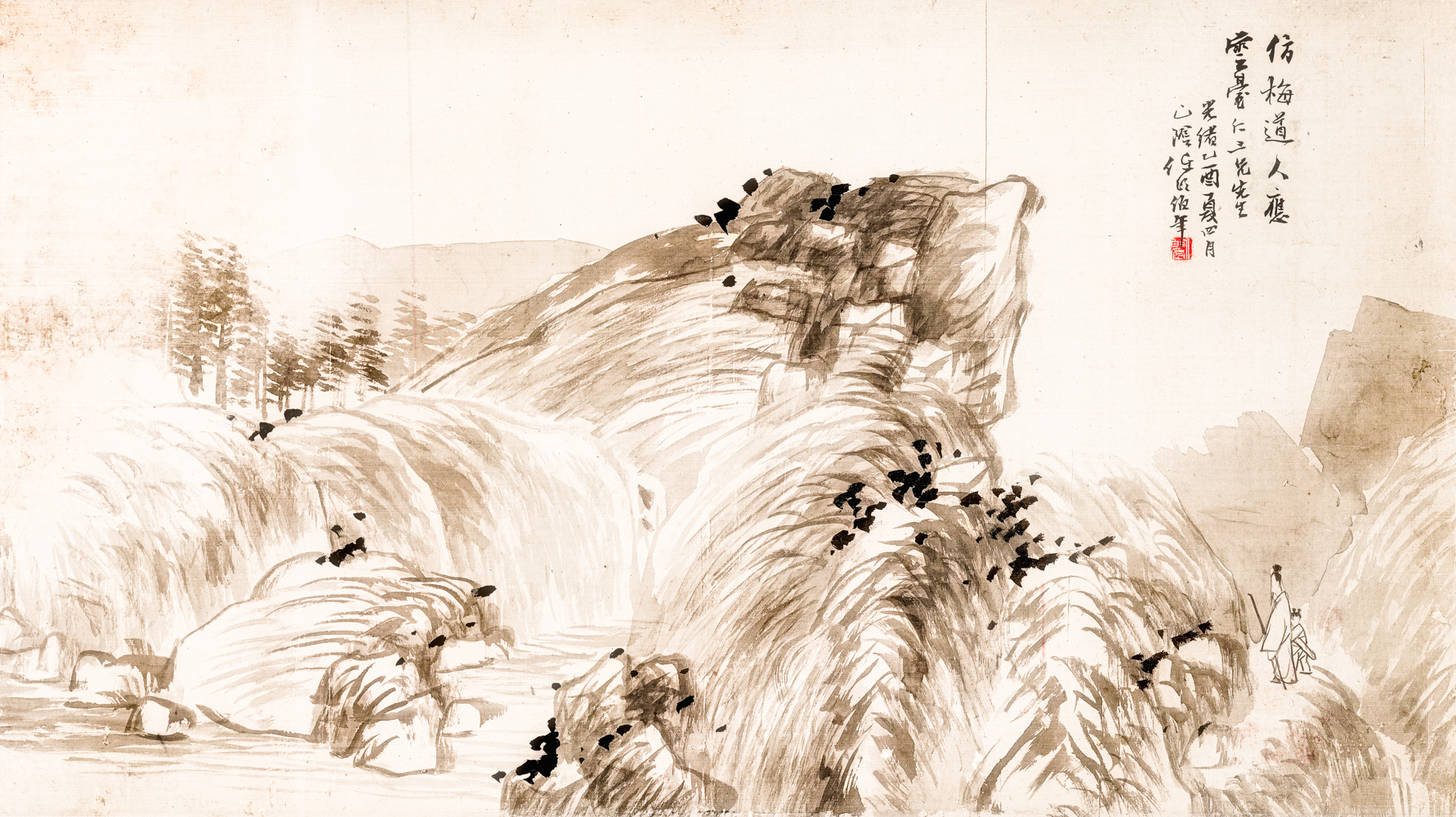
Ren Yi (Qing Dynasty, i.e., Ren Bonian, originally named Run, courtesy name Ciyuan, style name Xiaolou, later renamed Yi, courtesy name Bonian, alternative style names Shanyin Daoshang Xingzhe, Shou Daoshi, etc., 1840-1895) "Landscape in the Style of Mei Daoren"

Wu Changshuo (Qing Dynasty, originally named Jun, also named Junqing, courtesy name Changshuo, also signed Cangshi, Cangshi, many alternative style names, commonly used ones include Cangshuo, Laocang, Laofou, Kutie, Dalong, Fou Daoren, Shi Zunzhe, etc., 1844-1927) "The Seven Sages of the Bamboo Grove"
The Republican Era (1912-1949), accompanied by the Xinhai Revolution, saw the rise of the New Culture Movement. Cultural reformers such as Kang Youwei, Chen Duxiu, Liang Qichao, and Cai Yuanpei unanimously turned their critical gaze towards traditional Chinese painting. They exhibited a high degree of consensus in negating literati painting and promoting academic painting, even advocating for the reform of Chinese painting using Western realistic spirit. Institutions like the Hu Society and the Chinese Painting Research Society were established successively. Jin Cheng, who had previously presided over the establishment of the precursor to the Palace Museum – the Interior Ministry's Ancient Artifacts Exhibition Hall –First proposed the so-called orthodox painting theory that promoted the Tang and Song styles and sought to correct the shortcomings of Ming and Qing literati painting, regarding "meticulous brushwork" as the orthodox tradition. The Northern landscape painting scene, centered around Beijing and Tianjin, gathered a large number of painters. Most of them turned their attention to the landscapes of the Song and Yuan dynasties. Some built their foundation from the Northern School, emphasizing the study and inheritance of academic painting and professional painter styles; others devoted themselves to a North-South fusion, prioritizing the Northern School, and valued the depiction and creation of scenicartistic conception. Pu Ru adopted the compositional methods of the Southern School's Ma-Xia tradition, emphasizing outlined forms with less texturing washes, eschewing ornate refinement, and establishing a unique style characterized by a stern, rugged, and clear rigidity. Chen Shaomei, starting from the styles of Ming painters Zhou Chen and Tang Yin, traced back to Ma Yuan and Xia Gui, and broadly adopted the legacy of Guo Xi, Liu Songnian, and Zhao Mengfu, pushing the vigorous ink style of the Northern School towards a direction of refined elegance. The Jiangnan landscape painting scene, centered in Shanghai, also exhibited more diverse and varied developments. In 1926, Jin Cheng passed away. The Chinese Painting Research Society and the Hu Society continued to promote the trend of learning from Song and Yuan masters. However, influenced by the Southern painting scene's reverence for the Four Monk's painting styles and the Epigraphic Freehand school, the gradual rise of painters like Xiao Xun, Qi Baishi, and Chen Banding occurred. Xu Beihong (who championed European traditional realistic style) took leadership at the Beijing Art College. In 1927, Wu Changshuo passed away, ushering in a new period of diverse artistic styles. The rise of the "Three Wus and One Feng" (Wu Hufan, Wu Zheng, Wu Zishen, and Feng Chaoran) occurred. In the early 1940s, Zhang Daqian from the Shanghai painting scene, along with Xie Zhiliu, traveled west across the deserts, studying the cave temples intently, seeking the tradition of colored painting from before the Song and Yuan, dating back to the Jin and Tang dynasties. The "Two Gaos and One Chen" (Gao Jianfu, Gao Qifeng, Chen Shuren), founders of the modern Lingnan School, aimed to revolutionize Chinese painting with the principle of "compromising between China and the West, blending the ancient and modern," using the depiction of real life to "awaken the national soul."
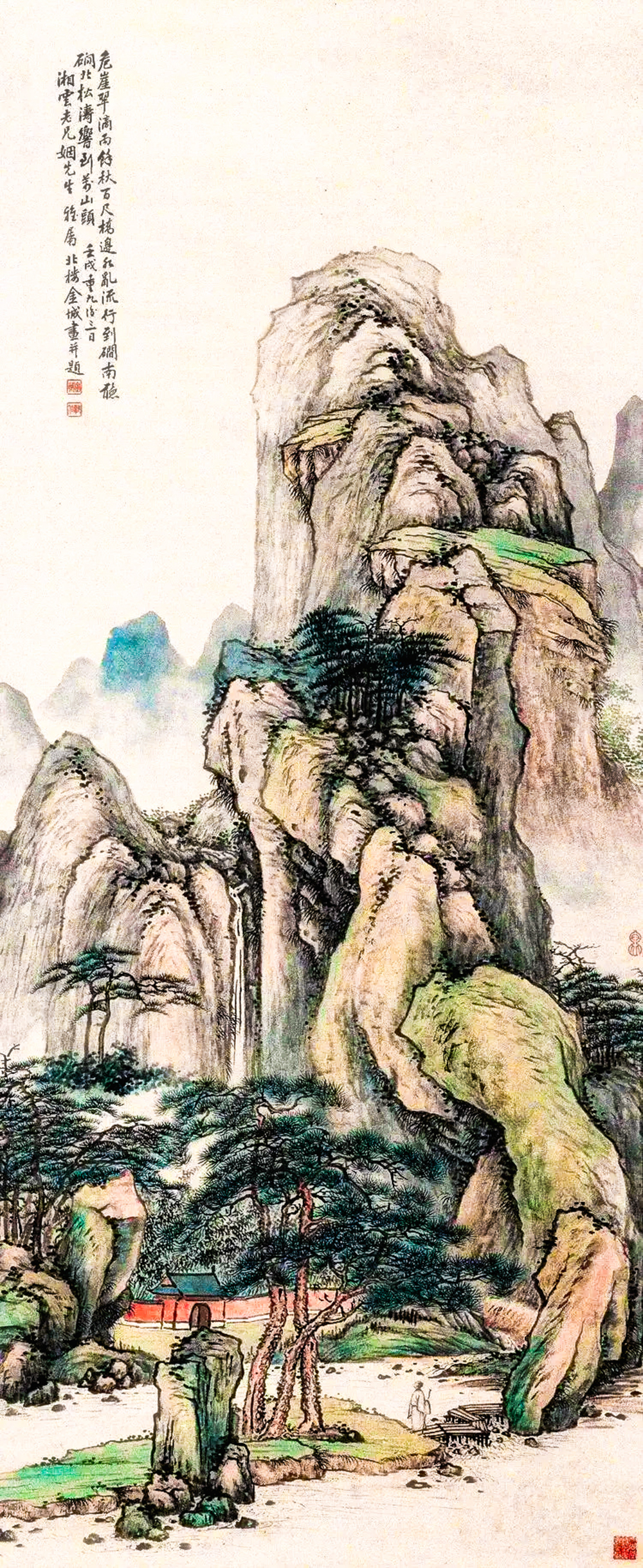
Jin Cheng (Republican Era, originally named Shao Cheng, courtesy names Gongbo, Gongbei, style names Beilou, also Ouhu, alternative names Ouhu, Yuyin, 1878-1926) "Seeking the Temple in Autumn Mountains"
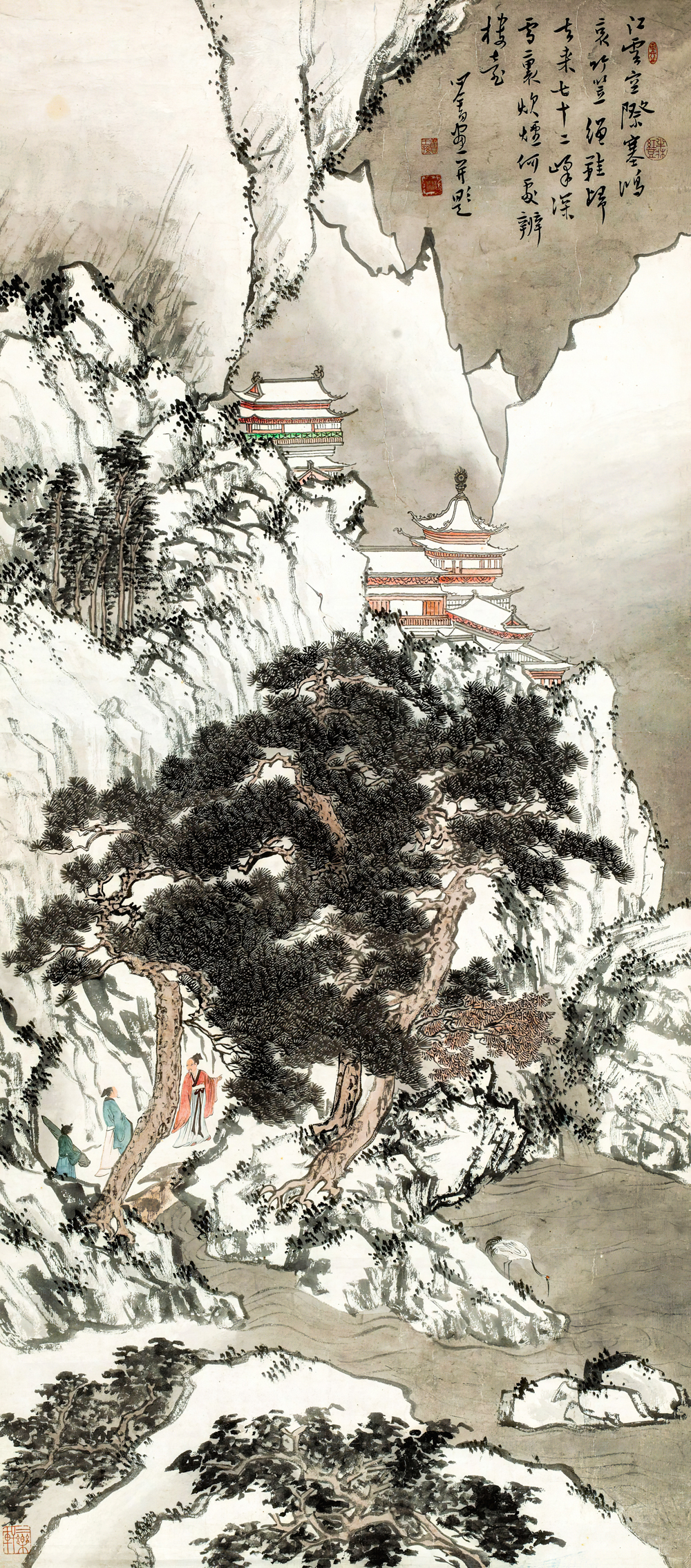
Pu Ru (Republican Era, courtesy name Xinyu, alternative style name Xishan Yishi, 1887-1963) "Snowy Tower"
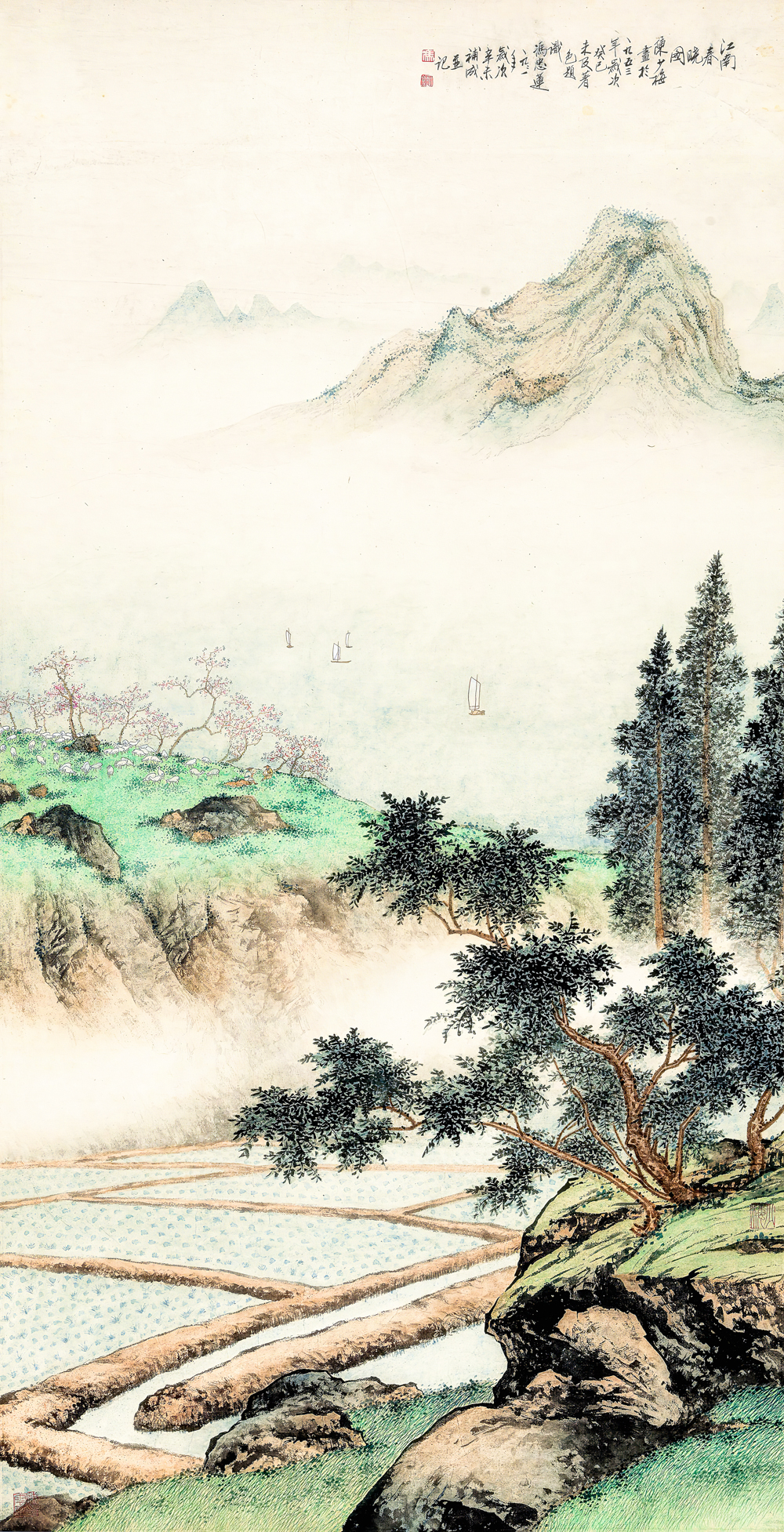
Chen Shaomei (Republican Era, given name Yunzhang, also Yun Chun, style name Shenghu, courtesy name Shaomei, 1909-1954) "Spring Dawn in Jiangnan"
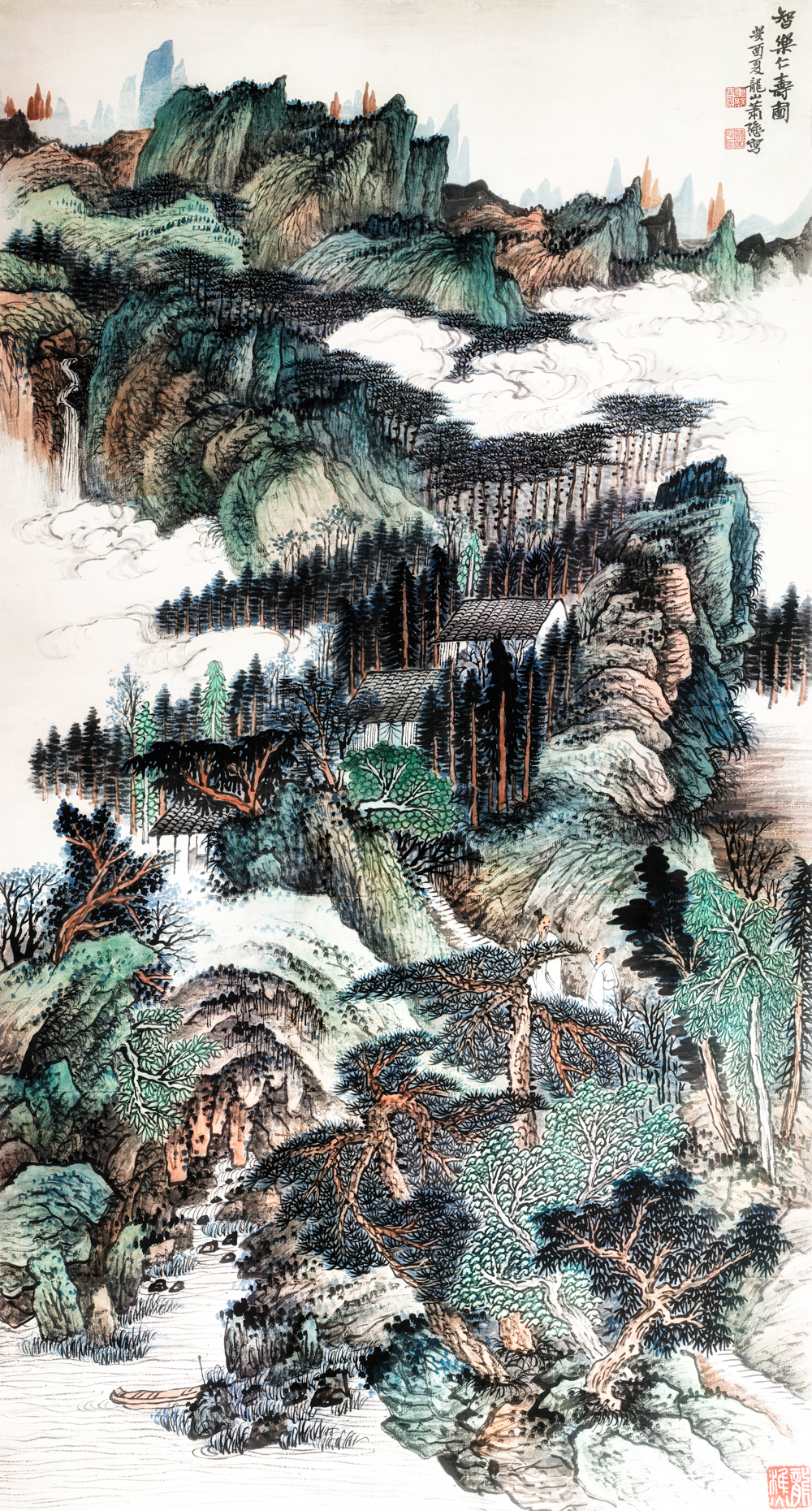
Xiao Xun (Republican Era, originally named Xiao Xun, courtesy name Qianzhong, style name Da Long Shan Qiao, 1883-1944) "Picture of Wisdom, Joy, Benevolence, and Longevity"

Qi Baishi (Republican Era, given name Huang, courtesy name Pingsheng, style names Baishi, Baishiweng, Laobai, also Jiping, Laoping, Jieshanweng, Qida, Mu Jushi, Sanbaishi Yin Fuweng, 1864-1957) "Plantain Lodge"
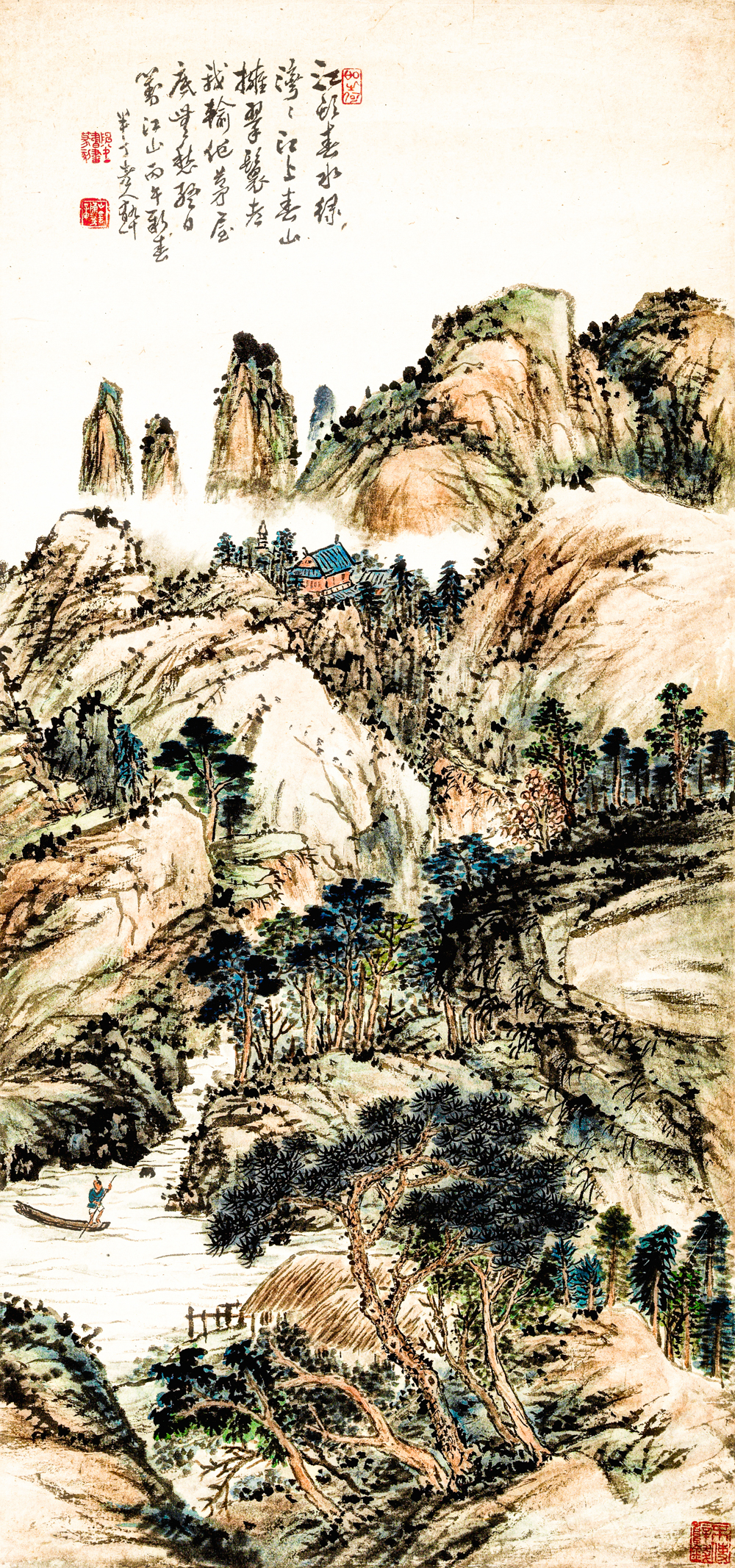
Chen Banding (Republican Era, i.e., Chen Nian, 1876-1970) "Landscape Painting"
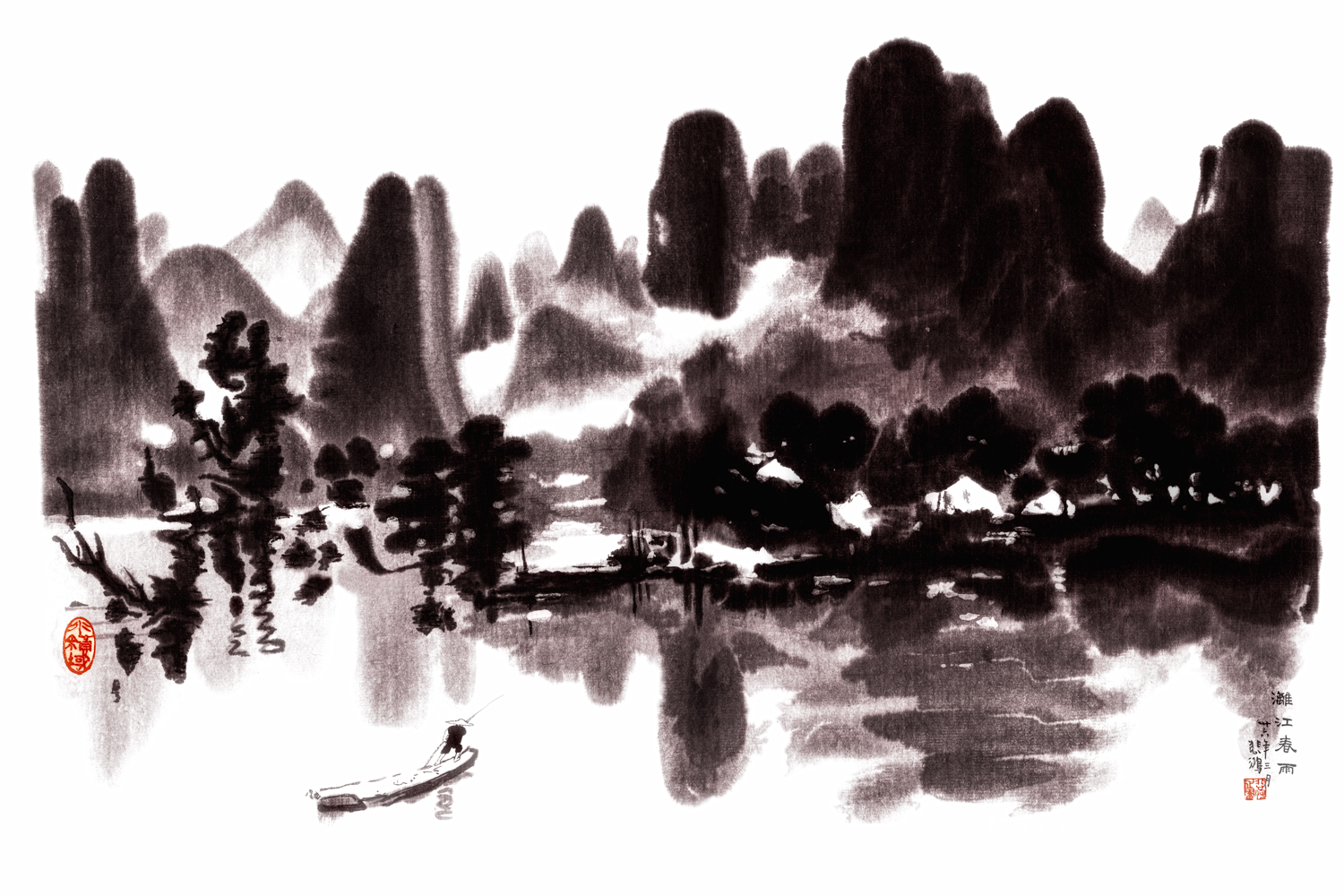
Xu Beihong (Republican Era, originally named Xu Shoukang, 1895-1953) "Spring Rain on the Li River"

Wu Hufan (Republican Era, originally named Yi Yan, courtesy name Yujun, later renamed Wan, courtesy name Dongzhuang, also named Qian, alternative name Chou Yi, style name Qian'an, signed paintings Hufan, 1894-1968) "Strange Peaks Piercing the Clouds"

Wu Zheng (Republican Era, courtesy name Daiqiu, given name Zheng, 1878-1949) "Landscape Painting"
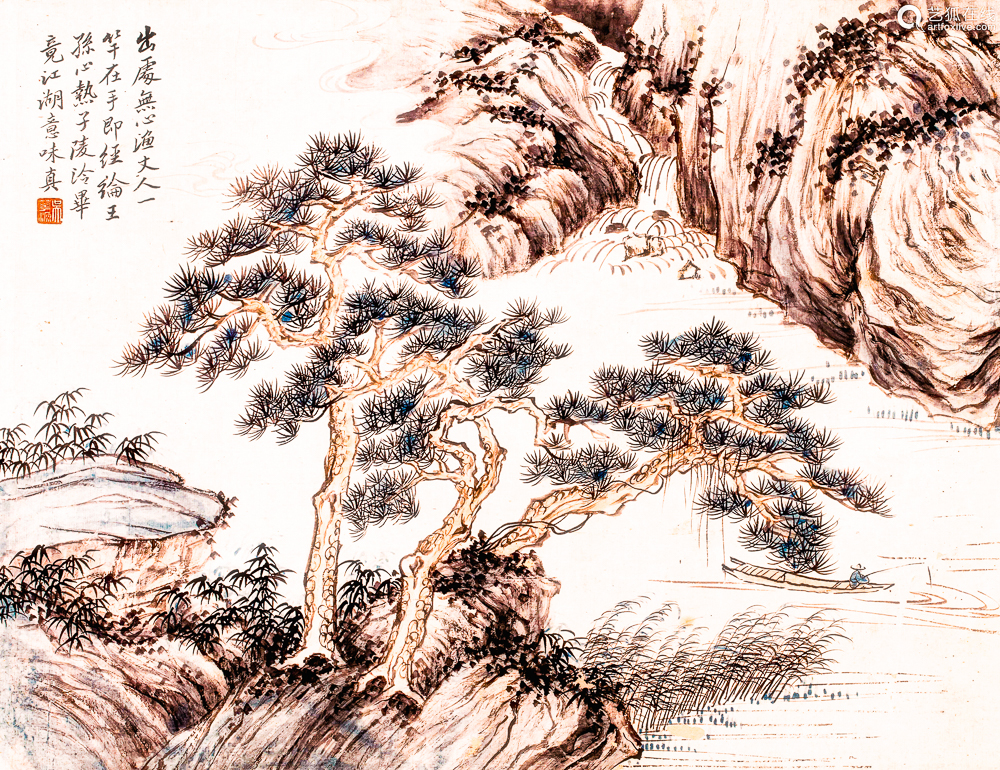
Wu Zishen (Republican Era, originally named Hua Yuan, initial courtesy name Yucun, later courtesy name Zichen, style name Taowu Jushi, 1893-1972) "Fishing Song on the Spring River"
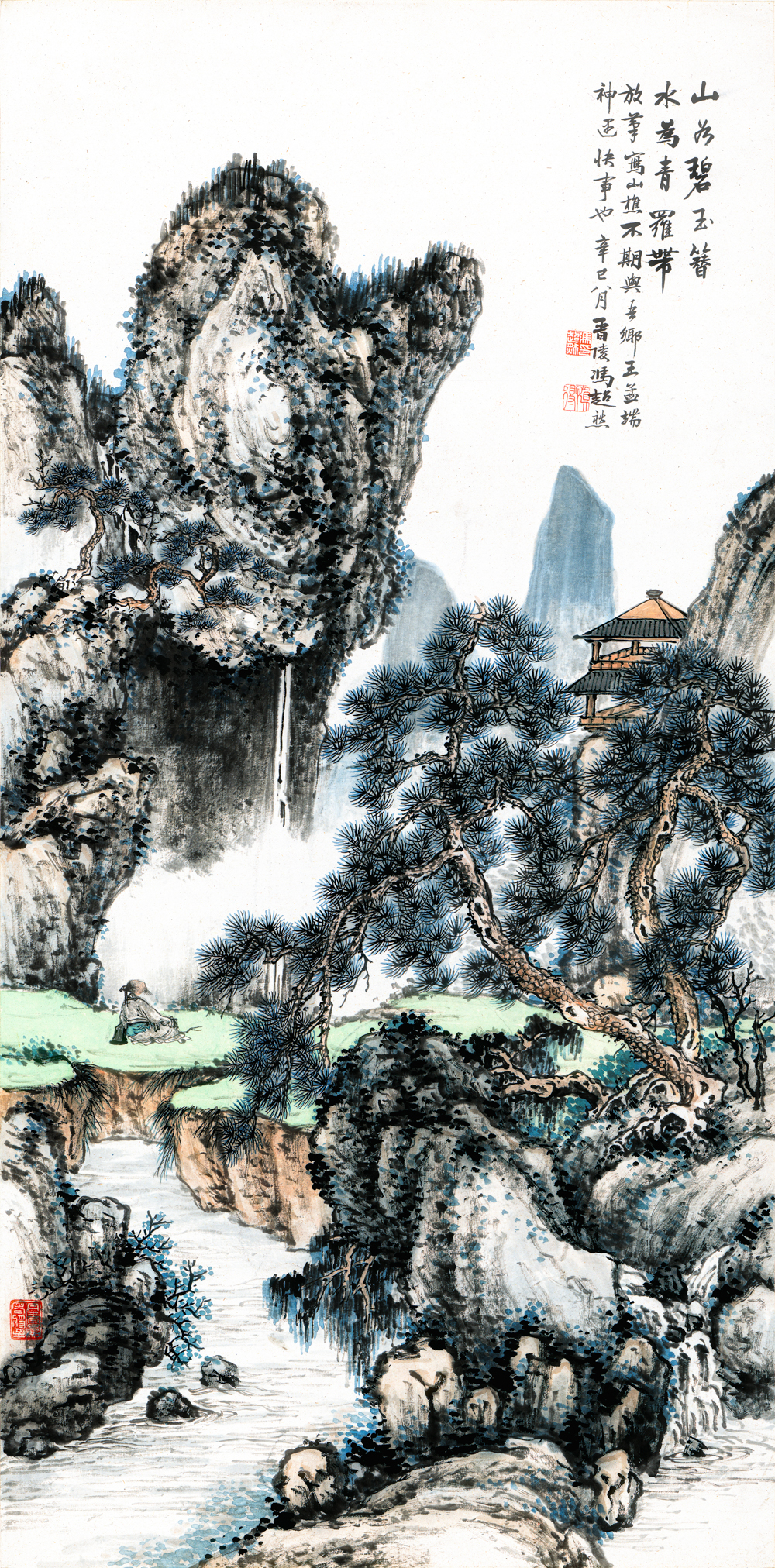
Feng Chaoran (Republican Era, given name Jiong, courtesy name Chaoran, style name Dige, late style name Shen De, 1882-1954) "Viewing the Waterfall"

Zhang Daqian (Republican Era, originally named Zhengquan, later renamed Yuan, courtesy name Jiyuan, style name Daqian, alternative style name Daqian Jushi, Xialigang Ren, studio name Dafeng Tang, 1899-1983) "Love Trace Lake"

Xie Zhiliu (Republican Era, originally named Zhi, courtesy name Zhiliu, late style name Zhuangmuweng, studio names Yuyin Xitang, Duzhai, Yanjiang Lou, Kuhuang Zhai, 1910-1997) "Bright River with Flowers and Bamboo"

Gao Jianfu (Republican Era, given name Lun, courtesy name Jianfu, 1879-1951) "Picture of Mist and Xia"
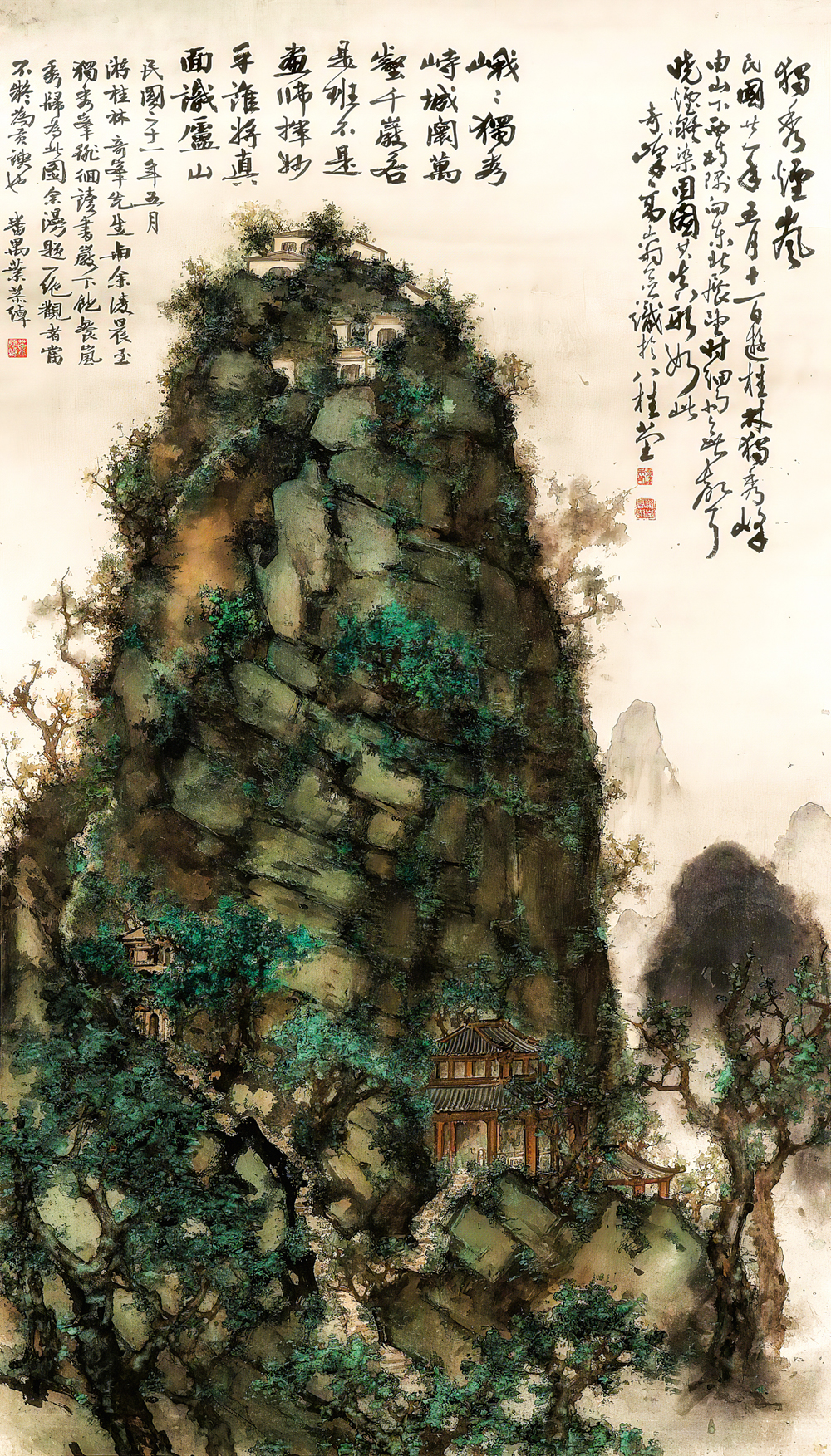
Gao Qifeng (Republican Era, given name Weng, courtesy name Qifeng, 1889-1933) "Solitary Peak in Misty Haze"

Chen Shuren (Republican Era, 1884-1948) "Waterfall at Dinghu Lake"
After the founding of the People's Republic of China (1949-present), from the convening of the First National Congress of Literary and Art Workers to the reorganization of art academies and the establishment of several national painting institutes, social painters active in the late Qing and Republican periods were absorbed into the new PRC system. Pan Tianshou served as president of the National Art Academy in 1945 and as president of the Zhejiang Academy of Fine Arts in 1959. He was full of confidence and determination in inheriting and developing national painting and formed a comprehensive system for Chinese painting education. Art advocated "revolutionary realism." The literati landscape painting school, headed by Zhao Mengfu and culminating in Dong Qichang and the Four Wangs, was criticized as "formalism" due to its characteristic of "imitating the ancients" and was pushed to the opposite side of "realism." Emphasis was placed on the "class character" of art, promoting an aesthetic taste that was bold, bright, and popular. Conversely, styles that were elegant, gentle, and refined were relegated to "decadent art" and rejected. During this period, Hu Peiheng broke the patterned accumulation of brush and ink seen in Ming and Qing landscape painting, strengthening the sense of depth and layering in landscapes. Qi Baishi used his freehand bird-and-flower painting techniques for simplified, freehand landscape painting, imbuing his works with a strong individuality and sense of form by housing strange simplicity within simple. Huang Binhong expressed the "inner beauty" of landscapes through his robust, lush, and seemingly unkempt brush and ink personality, thus pushing literati freehand landscape painting to new heights. Guan Shanyue, who was significantly influenced by Fu Baoshi, began to use mostly raw paper for painting, employing less washes and more brushwork. Their insistence on sketching from life and focusing on reality meant that landscape painting, which originally did not hold a prominent position in Lingnan School painting, coincided with the realist orientation promoted after the founding of the PRC. A notable phenomenon after the 1950s was the shift of China's cultural and artistic center from the South, centered on Shanghai, to the North, centered on Beijing. The Xinjining Painting School in the South, the Chang'an Painting School in the Northwest, and the landscape painting school represented by Li Keran in the North rapidly rose to prominence amidst the trends of the time, with Li Keran, Fu Baoshi, and Shi Lu being particularly outstanding. Li Keran strengthened the role of brush and ink, especially ink techniques, in shaping the imagery andartistic conception of landscapes, breaking through the old formulas of realistic depiction. Fu Baoshi, through his free-spirited and expressive brush and ink personality, passionately interpreted his real-life feeling. Shi Lu, sensing the strange, rugged, and restless energy of the desolate Loess Plateau, developed a quivering brushstroke that opened up another realm for expressing the authenticity of perception. Lu Yanshao used outline and wash methods to depict the gathering and scattering of clouds in the sky and the surging waves of rivers, or utilized the effects of ink diffusion to vividly express the form and substance of mist, clouds, and flowing water. Zhang Daqian, who moved overseas in the 1950s, encountered Abstract Expressionism during his travels in Europe and America and, amidst declining eyesight, pioneered a new style of splashed ink and splashed color. In the 1980s, Liu Haisu and Zhu Qizhan, with their techniques of integrating Chinese and Western elements (the fusion school), also developed splashed ink and splashed color landscape painting. Lin Fengmian pursued integration from the perspectives of traditional Chinese freehand painting and Western modern painting, characterized by the brilliant colors of Western painting, while showing a tendency in his later years to strengthen the significance of ink. His student Wu Guanzhong carried forward this Sino-Western combined artistic style. Following the period in the 1980s and 1990s when Chinese art circles rapidly traversed a century of Western art transformations, with modernism and postmodernism constituting the basic context of contemporary art in a symbiotic and overlapping manner, "conceptual ink painting" also impacted the field of landscape painting, alongside the splashed color of Zhang Daqian, the textures of Liu Guosong, the abstraction of Zao Wou-Ki, and other artists.

Pan Tianshou (courtesy name Dayi, self-titled A Shou, Shouzhe, 1897-1971) "The Land is Rich in Beauty"
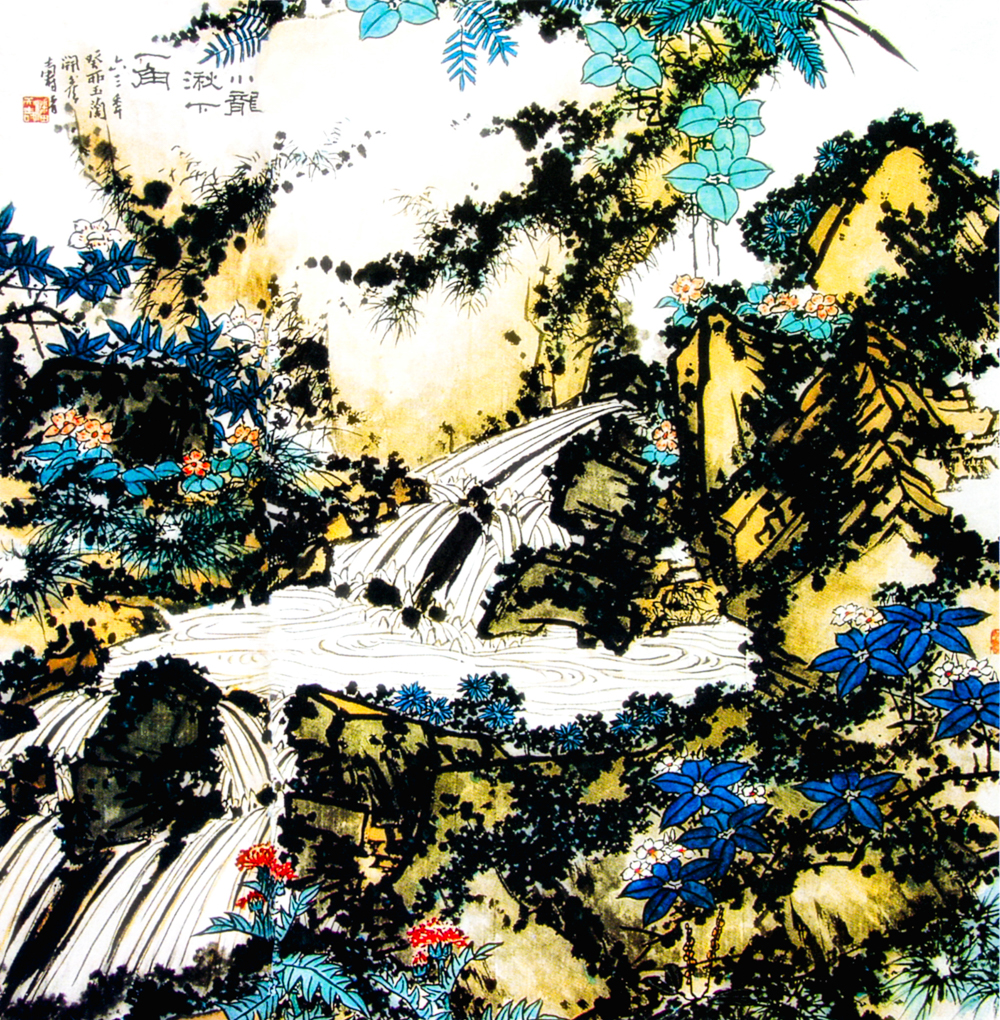
Pan Tianshou (courtesy name Dayi, self-titled A Shou, Shouzhe, 1897-1971) "Below the Corner of Xiaolongqiu"

Hu Peiheng (genealogical name Xiquan, also named Heng, courtesy name Peiheng, style name Leng'an, nickname Hutuketu, 1892-1962) "Scenery of the Li River Mountains"
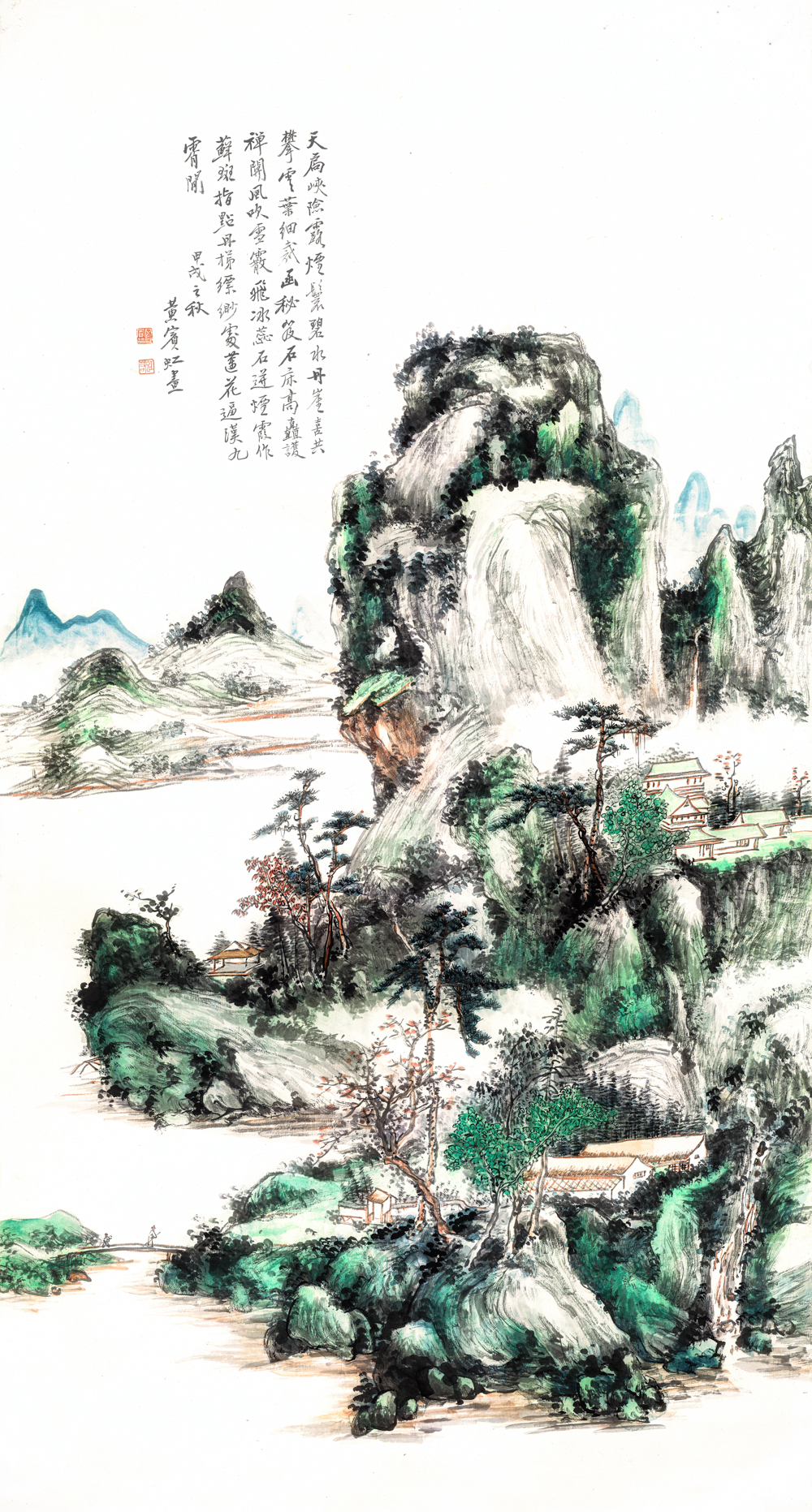
Huang Binhong (original name Mao Zhi, given name Zhi, courtesy names Pucun, Pucen, also written Pucheng, Piqin, style name Binhong, alternative signatures Yuxiang, Hong Sou, Huangshan Shan Zhong Ren, etc., 1865-1955) "Landscape in Imitation of the Ancients"

Fu Baoshi (original name Changsheng, given name Zhongzhou, courtesy name Qingyuan, school name Ruilin, style name Baoshi Zhai Zhuren, 1904-1965) "Tiger Crouching, Dragon Coiling, Today Surpasses the Past"
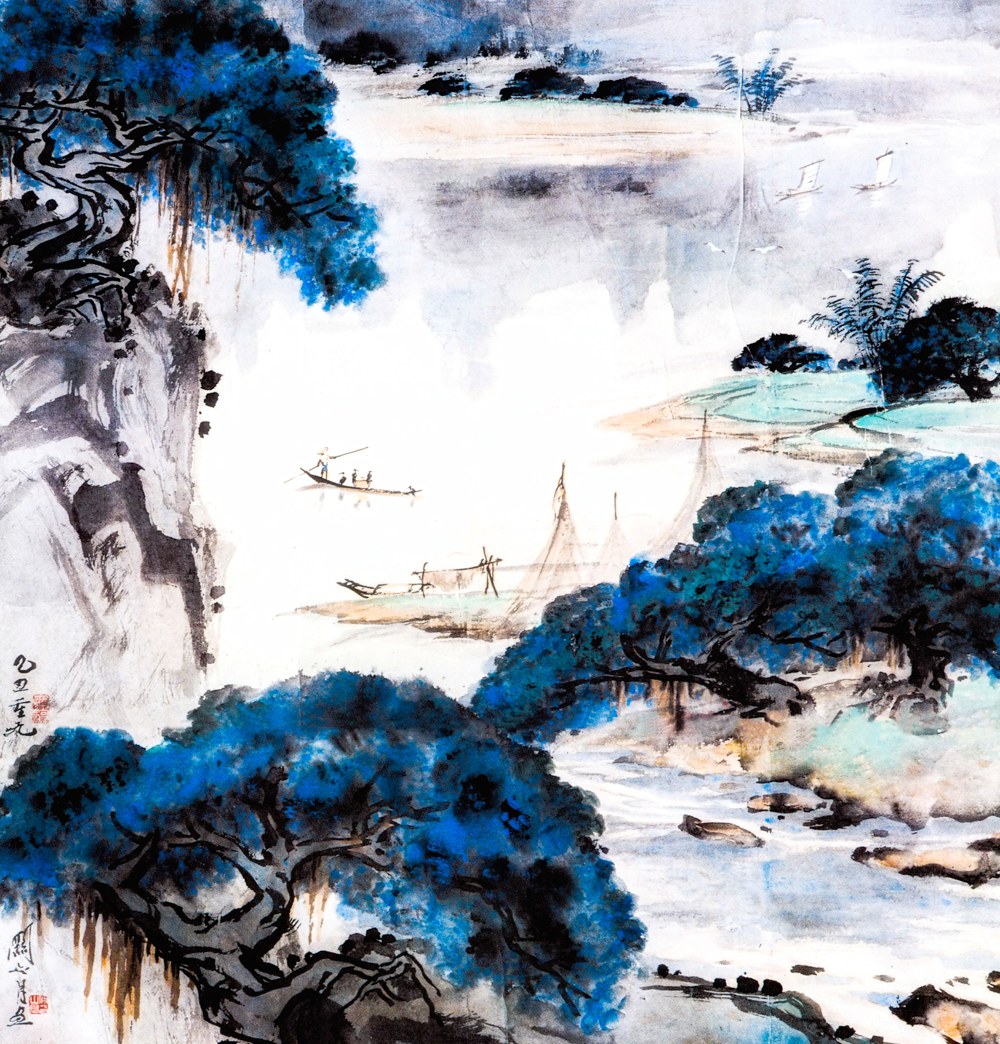
Guan Shanyue (original name Guan Zepei, 1912-2000) "Lofu Mountain Hydropower Station"
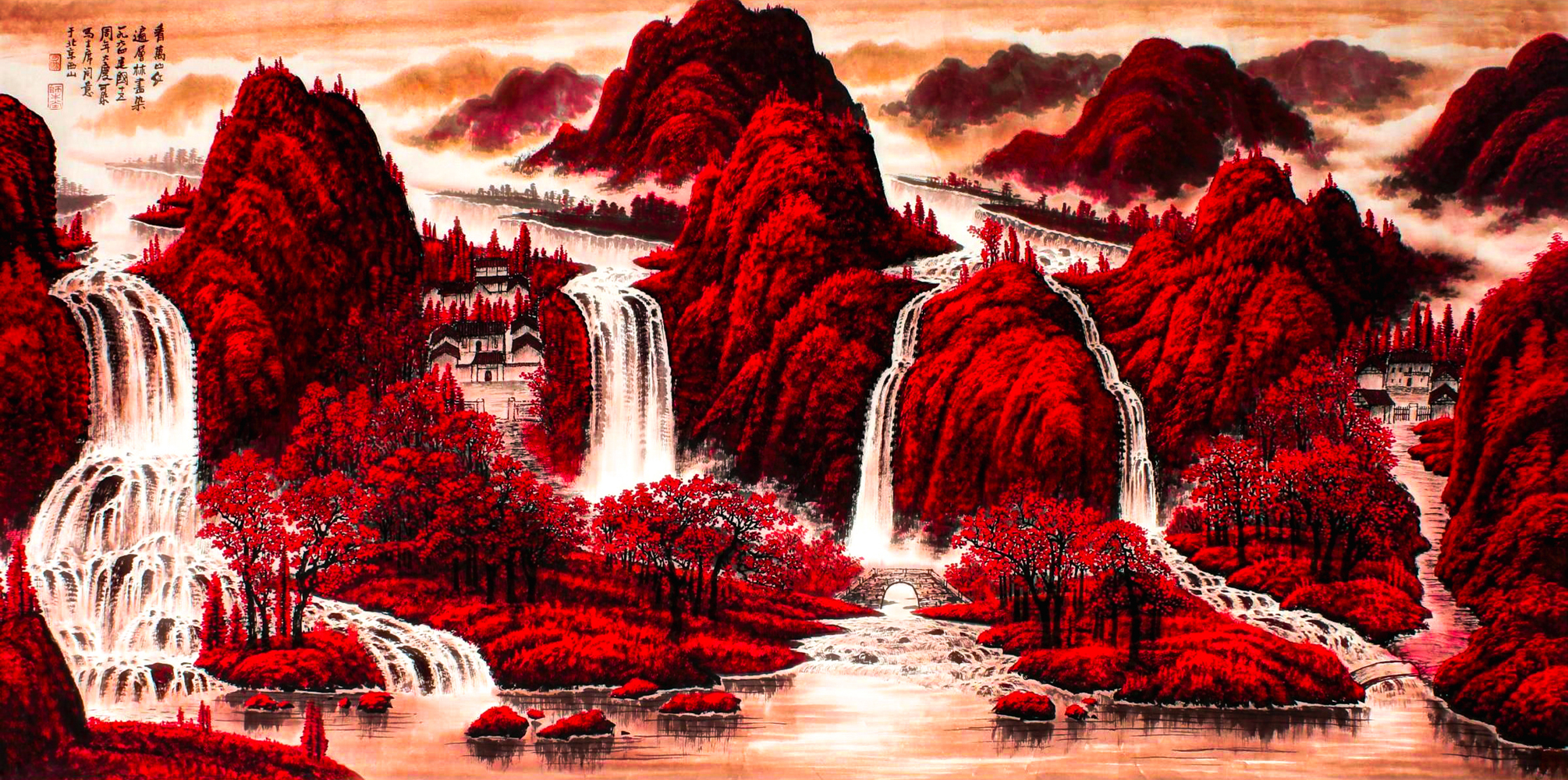
Li Keran (original name Li Yongshun, 1907-1989) "Redness Widespread over Ten Thousand Mountains"
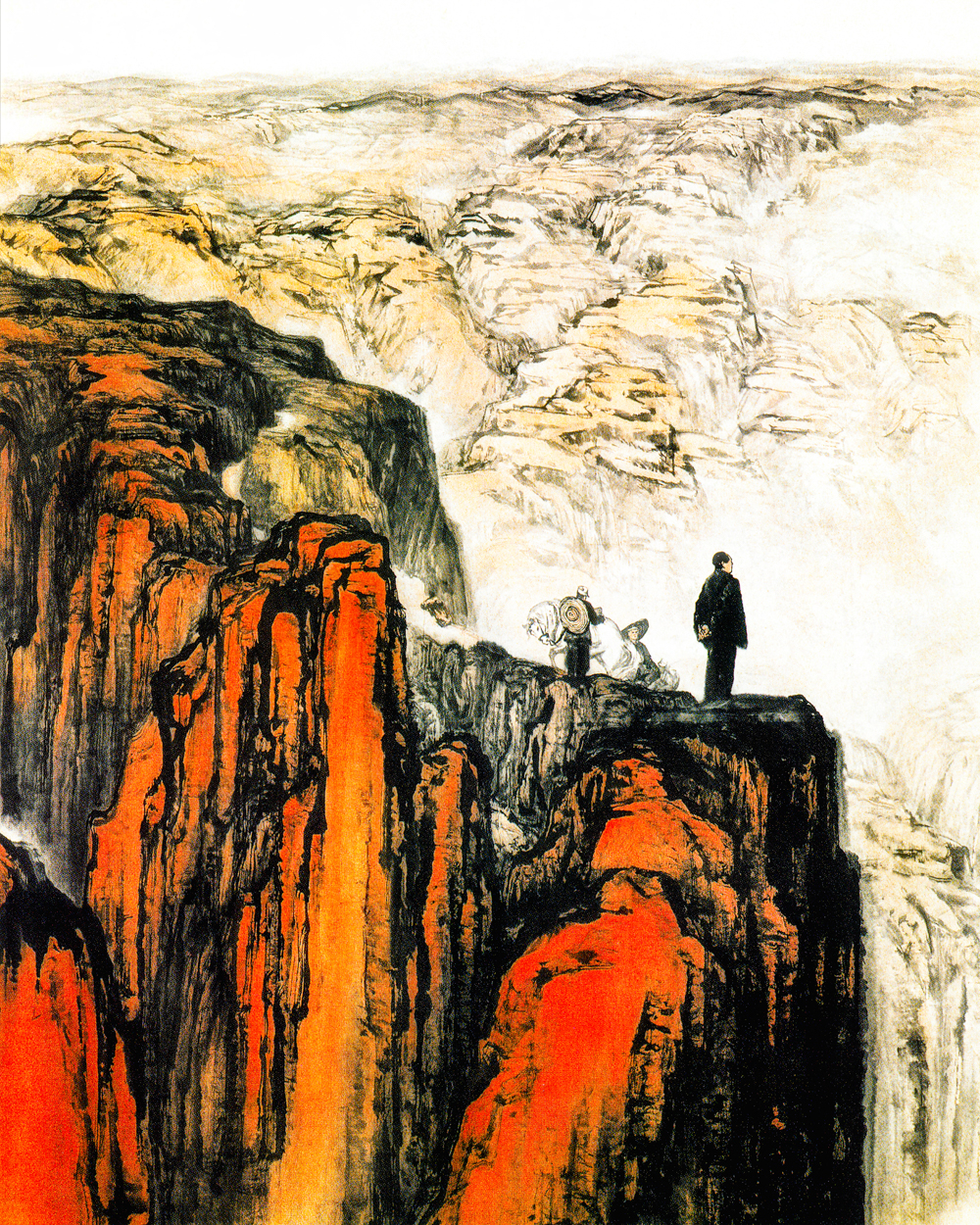
Shi Lu (1919-1982) "Fighting in Northern Shaanxi"
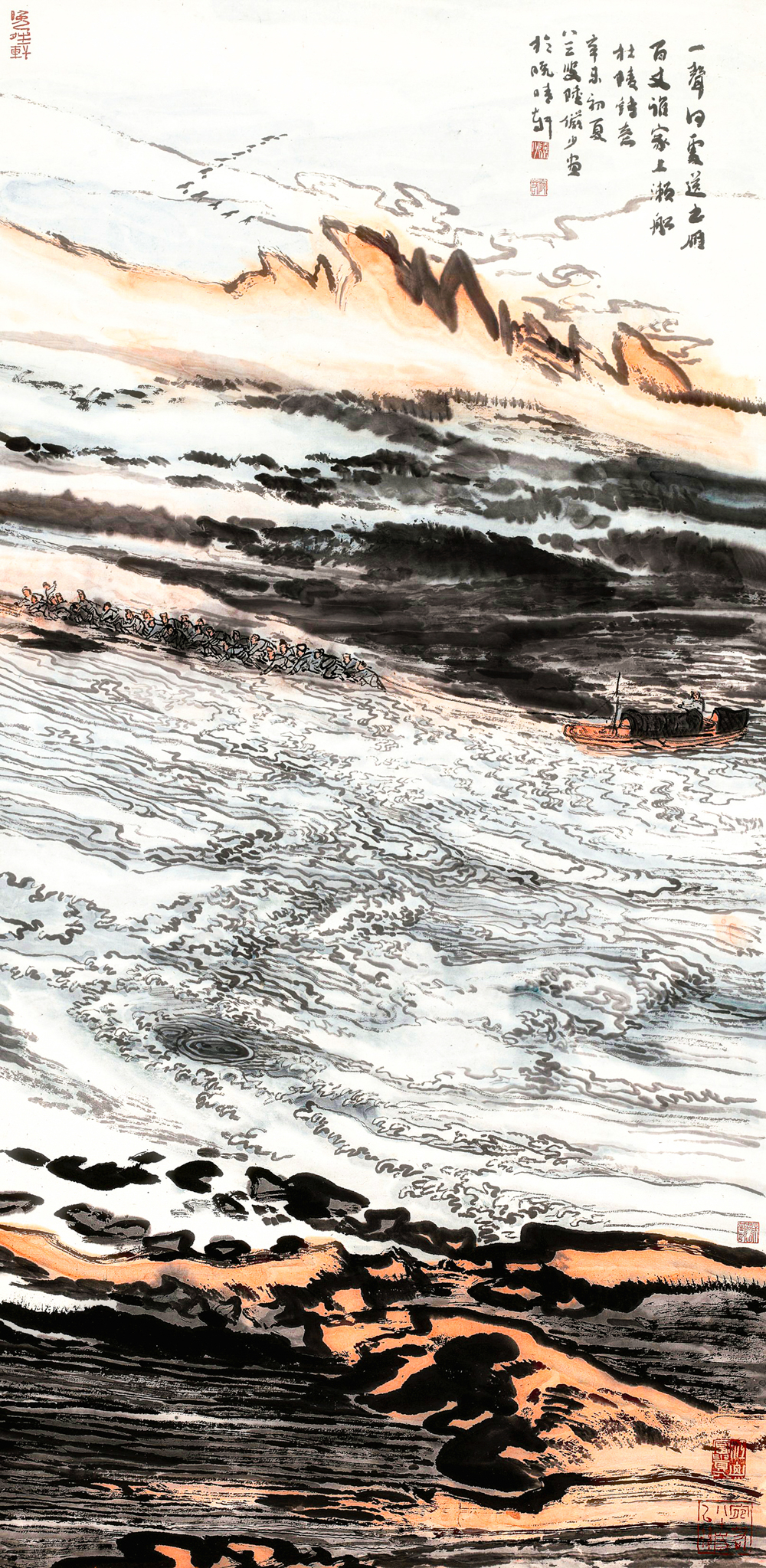
Lu Yanshao (given name Di, courtesy name Wanruo, 1909-1993) "Illustration for Du Fu's Poem"

Liu Haisu (given name Pan, courtesy name Jifang, style name Haiweng, 1896-1994) "Mount Huang"
Zhu Qizhan (1892-1996) "Horizontal View as Ridge, Side View as Peak"
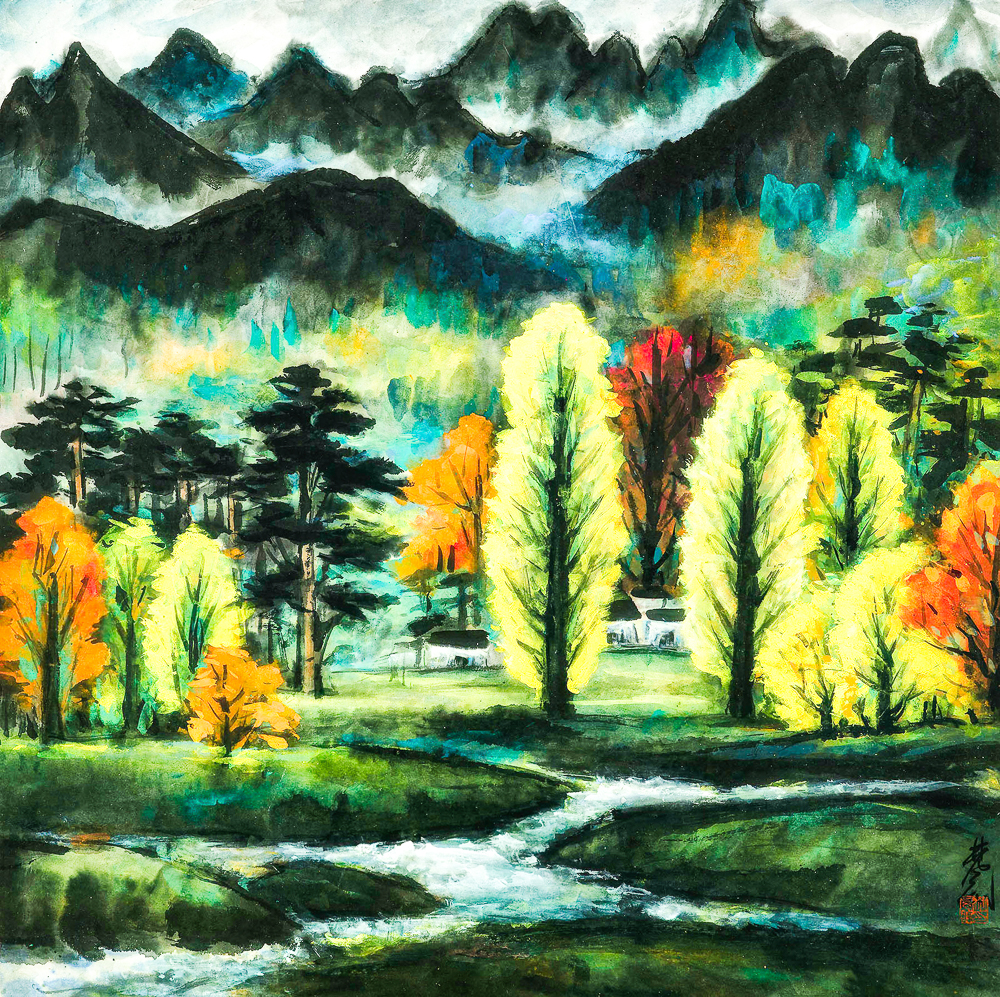
Lin Fengmian (original name Shaoqiong, Jiansheng, later changed name to Fengming, also named Fengmian, 1900-1991) "Autumn"
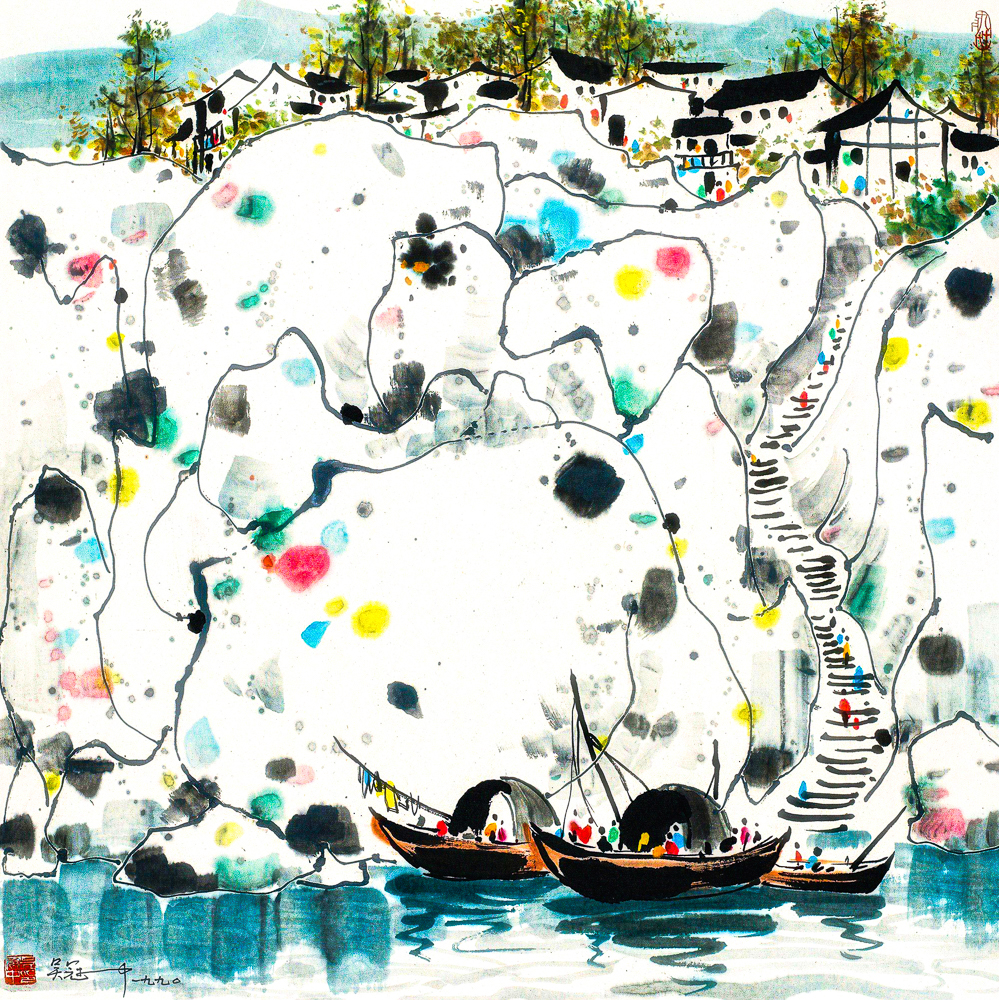
Wu Guanzhong (1919-2010) "Jiangnan Water Village"

Liu Guosong (1932-) "Wind and Tree"
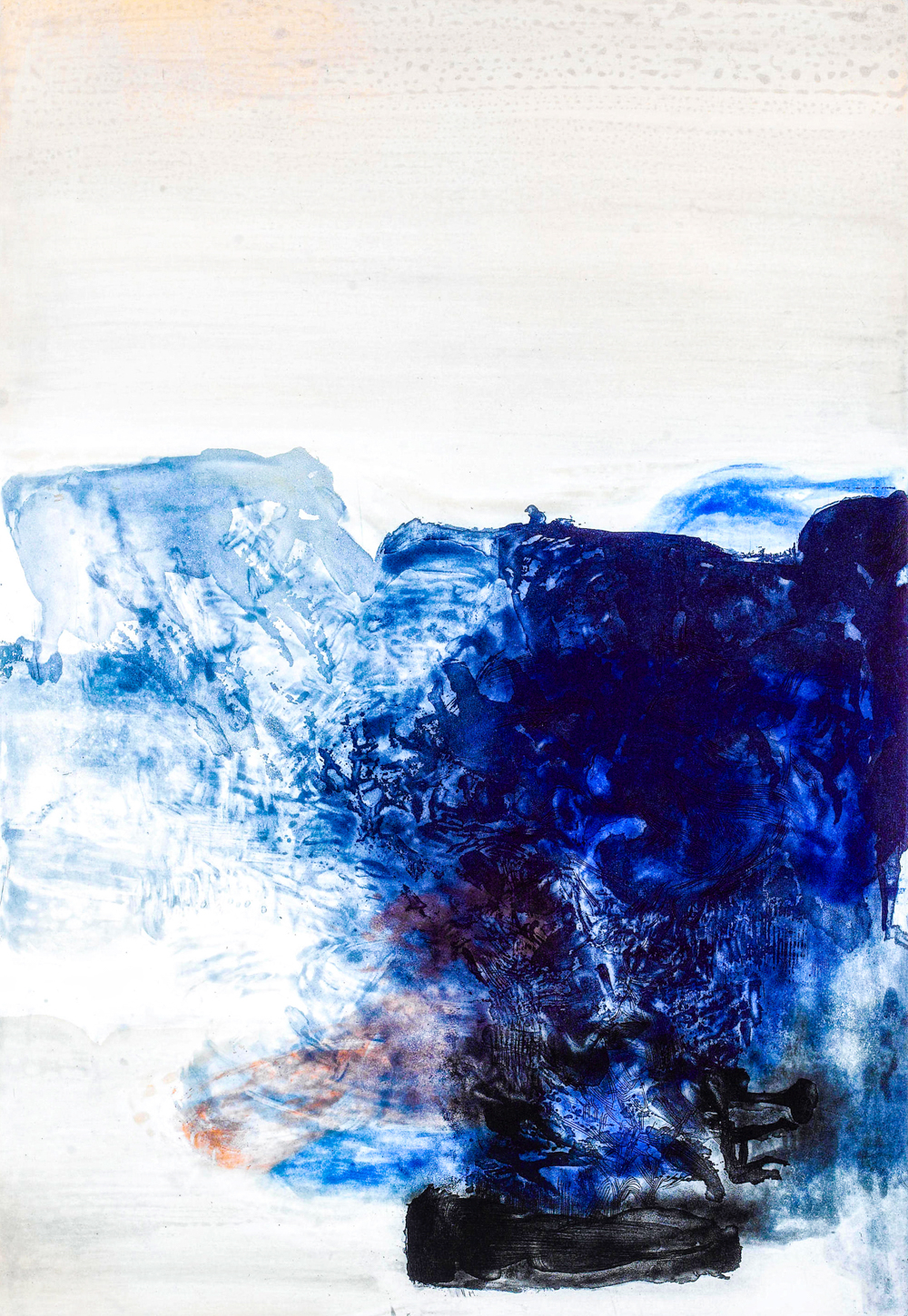
Zao Wou-Ki (1921-2013) "Landscape · Heart of the Mirror"
© CopyRight 2023 Yu Yue Photocopying Shanghai ICP No. 2023013283




